2. 教育部含油气盆地构造研究中心, 杭州 310027;
3. 江西省地矿资源勘查开发中心, 南昌 330030;
4. 中国科学院南海海洋研究所边缘海地质重点实验室, 广州 510301
2. Research Center for Structural Analysis of Petroliferous Basins, Ministry of Education, Hangzhou 310027, China;
3. Center of Exploration and Development of Geology and Mineral Resources of Jiangxi Province, Nanchang 330030, China;
4. CAS Key Laboratory of Marginal Sea Geology, South China Sea Institute of Oceanology, Chinese Academy of Sciences, Guangzhou 510301, China
古太平洋板块的俯冲对于东亚陆缘中生代的构造演化有着重要影响,尤其是导致了中生代大规模的岩浆作用和构造运动(Zhou and Li, 2000; Li and Li, 2007; Shu et al., 2009; Li et al., 2012)。这一时期发育了从西菲律宾到台湾东部、日本西南部的俯冲增生杂岩带(Faure et al., 1989; Wakita and Metcalfe, 2005; Zamoras et al., 2008),确立了一个北东-南西向的陆缘俯冲带。
一般认为,侏罗纪时期是华南陆块由特提斯构造域向古太平洋构造域转变的重要时期(董树文等, 2008; 张岳桥等, 2009, 2012; 张国伟等, 2013)。侏罗纪华南东部内陆地区广泛发育了A型花岗岩、双峰式火山岩、玄武岩等代表伸展构造的岩石组合(Li et al., 2007; He et al., 2010; Yu et al., 2010; Huang et al., 2011; Ye et al., 2013),并伴随形成了广泛的伸展断陷盆地(Shu et al., 2009; Meng et al., 2015; Pang et al., 2016; 王彬等, 2006; 舒良树等, 2011)。华南东部内陆地区在侏罗纪处于陆内伸展背景这一认识已逐渐成为学术界共识(Li et al., 2007;Yu et al., 2010;舒良树等,2011),但对于该时期华南东部陆缘构造环境还存在不同的观点。一部分学者主张早侏罗世开始华南东部整体已经处于伸展拉张状态(Shu et al., 2008; Yu et al., 2010)。而另一部分学者认为在东部陆缘可能存在构造挤压,主要表现为侏罗系普遍遭受褶皱变形,与上覆地层角度不整合接触,并伴随着广泛的变质作用和推覆构造(Chen et al., 2004; Xiao and He, 2005; Cui et al., 2013; Dong et al., 2015; Xu et al., 2016b; 邢光福等, 2008),这些证据可能表明东部陆缘处于俯冲背景下的陆缘造山阶段(Cui et al., 2013; Li et al., 2013a, b; Xu et al., 2016a, b; Yuan et al., 2018; 邢光福等, 2008)或为挤压主导下的安第斯型活动大陆边缘(Li and Li, 2007; Li et al., 2012, 2016a, b; Dong et al., 2015; Yan et al., 2017),但对于该时期的具体构造环境仍缺少直接的火山岩石学的观测证据。
确定华南东部陆缘构造背景对我们认识华南中生代构造演变有着重要意义,但现今华南东部陆缘的大部分地区被白垩纪火山岩和沉积盆地所覆盖,极大地制约了对侏罗纪东部陆缘大地构造环境的认识(Li et al., 2012)。浙江地处华南东部中生代陆缘,是目前东部沿海地区侏罗系最为发育的地区之一,发育了多套这一时期的火山岩夹层(浙江省地质矿产局, 1989; 陈荣等, 2007),为认识侏罗纪华南陆块东部陆缘构造环境提供了重要线索。本文以浙东南侏罗纪毛弄组火山岩为对象,开展SHRIMP锆石U-Pb年代学、LA-ICP-MS锆石微量元素、全岩元素地球化学和Sr-Nd同位素研究,结合前人研究结果,探讨了华南东部陆缘侏罗纪岩浆作用的特征及其构造背景,为认识华南东部中生代陆缘弧的形成和演化提供关键性制约。
1 地质背景华南陆块位于欧亚大陆东南缘,由扬子和华夏两个地块在新元古代拼合而成(Li et al., 2004; Charvet, 2013; Zhang and Zheng, 2013; Zheng et al., 2013; Xia et al., 2018),并在中生代经历了多期构造-岩浆活动(Zhou et al., 2006)。在三叠纪,华南陆块西南边缘在早三叠世与印支地块斜向碰撞(Lepvrier et al., 2011; Vuong et al., 2013; Faure et al., 2014, 2016; Liu et al., 2015),同时在其北部边缘经历了与华北陆块的碰撞拼合(Ames et al., 1993; Li et al., 1993; Wang et al., 2011; Dong et al., 2011, 2013)。进入侏罗纪,欧亚大陆东部陆缘受到古太平洋板块俯冲作用的强烈影响,经历了广泛的构造变形和岩浆作用过程(Pirajno et al., 1997; Zhou et al., 2006; Li and Li, 2007; Dong et al., 2015)。当前对古太平洋板块向华南东部开始俯冲的时间还存在争论,一些学者认为是早-中侏罗世(Zhou et al., 2006; Shu et al., 2009)或早白垩世(Chen et al., 2008),另一部分学者则认为是在二叠纪(Li and Li, 2007; Isozaki et al., 2010)。
在华南东部内陆地区,侏罗纪岩浆岩出露广泛(图 1)。这一时期岩浆活动大体可以划分为两个阶段(Li et al., 2007):早-中侏罗世岩浆岩(195~165Ma)主要为双峰式火山杂岩和A型花岗岩、玄武岩(He et al., 2010; Yu et al., 2010; Zhu et al., 2010; Huang et al., 2011; Ye et al., 2013),还伴随有少量S型花岗岩(Li et al., 2007; He et al., 2010; 凌洪飞等, 2004);晚侏罗世岩浆岩(165~150Ma)规模较大,以高分异Ⅰ型花岗岩为主,并伴随有小规模的A型花岗岩和正长岩、玄武岩(Jiang et al., 2009; 柏道远等, 2005; 朱金初等, 2006; 徐先兵等, 2009)。上述岩石组合和地球化学特征总体指示了典型的伸展的构造特征。而在华南东部沿海等邻近俯冲带地区,侏罗纪岩浆岩规模较小,但分布相对广泛,以Ⅰ型花岗岩(Yui et al., 2009; Wang et al., 2016; Xu et al., 2016a, 2017; Zhu et al., 2016; Yuan et al., 2018)和中-酸性火山岩(Guo et al., 2012; Liu et al., 2012a, 2016; Li et al., 2014; 李亚楠等, 2015; 邢新龙, 2016)为主(图 1)。前人研究初步表明这些陆缘火山-侵入岩有着区别于陆内伸展型岩浆岩的岩石与地球化学特征,而与弧岩浆岩特征相似。此外,华南东部还有少量TTG岩石组合(Yuan et al., 2018; 冯艳芳等, 2014)和埃达克质岩体(Wang et al., 2012, 2015, 2016; Li et al., 2016a, b; Xia et al., 2016)出露。
研究区位于华南陆块东北缘,基底隶属华夏陆块部分。浙东南地区华夏陆块前寒武纪基底岩石主要分布在八都、陈蔡等杂岩和双溪坞群中,其中古元古代八都杂岩是现今已知最老的华夏陆块基底岩石(Li, 1997; Yu et al., 2009; Xia et al., 2012; Liu et al., 2014; 甘晓春等, 1995; 刘锐等, 2009)。区内断裂构造发育,发育3条深大断裂带,自西向东依次为江山-绍兴深断裂、余姚-丽水(政和-大埔)深断裂及长乐-南澳深断裂。浙东南晚中生代构造变动和火山活动极为频繁,形成了广布的白垩纪火山岩(浙江省地质矿产局, 1989)。侏罗纪火山岩岩性则以英安质和流纹质凝灰岩为主,主要以夹层形式分布于浙东南毛弄组含煤碎屑岩之中(图 2, 陈荣等, 2007; 王加恩等, 2016; 邢新龙, 2016)。侏罗纪早期侵入岩只在宁波澥浦等地出露(Li et al., 2012),晚期侵入岩记录则相对较多,以160~145Ma为主(顾明光等, 2011; 贾德龙等, 2013; 高万里, 2014; 王对兴等, 2015)。
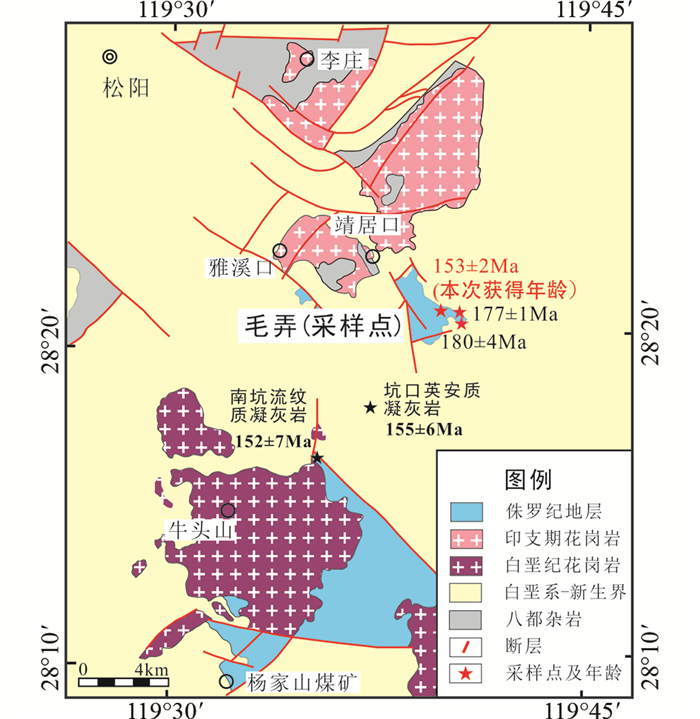
|
图 2 浙东南毛弄地区简要地质图(据浙江省地质矿产局, 1989) Fig. 2 Simplified geological map of Maonong region in the southeastern Zhejiang Province (after BGMRZ, 1989) |
浙江东南部毛弄组主要见于松阳毛弄,其次见于云和南坑、坑口和庆元左溪等处,出露面积约46.1km2(图 2),为一套含火山碎屑岩的陆相含煤沉积地层。代表剖面位于松阳毛弄煤矿区剖面。该剖面可分为下、中、上三段:下段为火山碎屑岩夹砂岩和煤层;中段以砂砾岩、砂岩为主,夹炭质页岩、凝灰岩,并夹三层煤,见有植物化石;上段以黄色含砾粗砂岩、砂砾岩及灰色页岩为主,夹煤3层,其上被下白垩统磨石山群覆盖。建组剖面中火山岩累计厚约400m,接近剖面总厚度的一半。底部出露不全,多与下白垩统呈断层接触(陈荣等, 2007)。
本次研究采样区位于浙东南松阳下毛弄公路附近,所有9个样品均采于毛弄组下段层位。其中4个样品(12MN05-1、12MN05-2、12MN05-3和17MN06-1)岩性为含花岗岩角砾英安质晶屑凝灰岩,呈灰绿色,晶屑凝灰结构(图 3a)。晶屑(约30%)主要为石英、斜长石、透长石、黑云母等,石英、长石等呈棱角状,石英可见港湾状熔蚀(图 3g)。岩屑(约20%)和角砾主要为一套呈肉红色中粗粒花岗岩,可见长20cm以上的火山集块。火山灰和玻屑(约50%)紧密堆积于岩屑和晶屑之间,玻屑部分脱玻化后有弱光性,呈弧面棱角状、鸡骨状(图 3g);3个样品(17MN03-1、17MN03-2和17MN03-3)岩性为英安质晶屑凝灰岩,呈灰绿色,具有晶屑凝灰结构,块状构造(图 3c, d)。主要包含晶屑,玻屑,岩屑(图 3e, f)。晶屑(约35%)主要为长石、石英、黑云母等,石英等呈棱角状,可见港湾状熔蚀,长石可见绢云母化。岩屑(约15%)主要为花岗质岩屑。玻屑脱玻化后有弱光性,部分呈弧面棱角状、鸡骨状;2个样品(12MN04-1和12MN04-2)岩性为流纹质玻屑凝灰岩,呈浅灰绿色,具玻屑凝灰结构(图 3b, h)。玻屑和火山灰约占75%,玻屑形态多样,多呈弧面棱角状、鸡骨状(图 3h)。晶屑(约20%)主要由石英、长石组成,可见少量黑云母。石英呈棱角状,可见港湾状熔蚀。岩屑(< 5%)主要为花岗质岩屑。
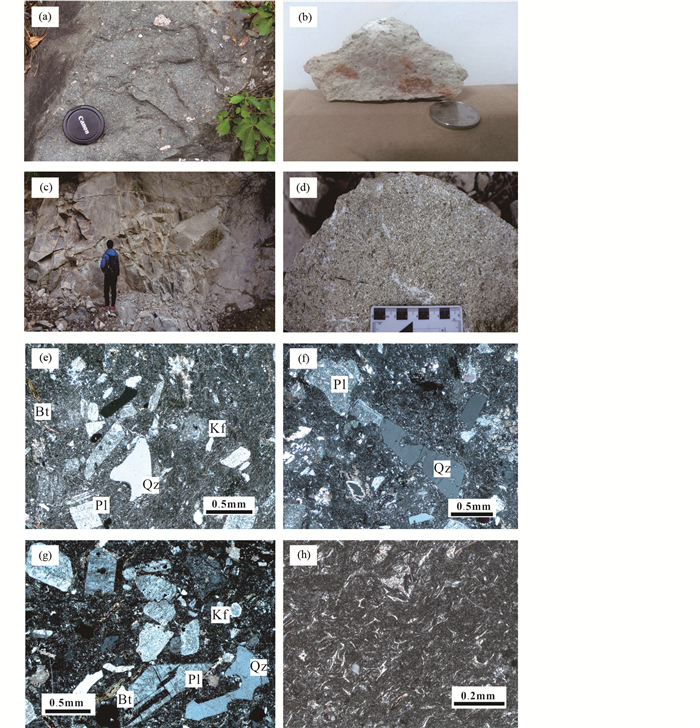
|
图 3 浙东南松阳毛弄组火山岩野外露头和标本特征(a-d)及正交偏光镜下显微照片(e-h) (a)含花岗岩角砾英安质晶屑凝灰岩;(b)流纹质玻屑凝灰岩;(c)英安质晶屑凝灰岩;(d)英安质晶屑凝灰岩(17MN03-2);(e)英安质晶屑凝灰岩镜下照片(17MN03-1);(f)英安质晶屑凝灰岩镜下照片(17MN03-2);(g)含花岗岩角砾英安质晶屑凝灰岩镜下照片(12MN05-1);(h)流纹质玻屑凝灰岩镜下照片(12MN04-1).Bt-黑云母;Pl-斜长石;Kf-钾长石;Qz-石英 Fig. 3 Outcrop photos (a-d) and photomicrographs under crossed nicols (e-f) of the volcanic rocks from the Maonong Formation in Songyang, SE Zhejiang (a) dacitic crystal tuff containing granitic breccias; (b) rhyolitic vitric tuff; (c) dacitic crystal tuff; (d) dacitic crystal tuff (17MN03-2); (e) micrograph of dacitic crystal tuff (17MN03-1); (f) micrograph of dacitic crystal tuff (17MN03-2); (g) micrograph of dacitic crystal tuff containing granitic breccias (12MN05-1); (h) micrograph of rhyolitic vitric tuff (12MN04-1). Bt-biotite; Pl-plagioclase; Kf-K-feldspar; Qz-quartz |
本次研究对松阳毛弄流纹质玻屑凝灰岩样品(12MN04-1)进行了SHRIMP锆石U-Pb年代学测试工作,测年锆石的分选采用人工重砂方法,粉碎后的岩石样品首先通过淘洗和使用重液等物理方法分离锆石,然后在双目镜下精选、剔除杂质。锆石制靶、锆石透、反射和阴极发光(CL)拍照以及U-Pb定年分析在北京离子探针中心完成,详细的制靶程序见宋彪等(2002)。测年实验前,先对制成靶的锆石进行反射光、透射光显微镜照相和阴极发光(CL)照相,综合分析锆石的形态和内部结构,以确定实验分析测点的最佳部位。锆石SHRIMP U-Pb年代学分析在北京离子探针中心SHRIMP Ⅱ上完成,具体分析流程参见文献(宋彪等, 2002; 刘敦一等, 2003)。实验过程中,选择标准锆石TEM(417Ma)进行同位素分馏校正,使用标准锆石M257(年龄为561.3Ma,U含量为840×10-6)对待测锆石样品及TEM标样(417Ma)的U、Th、Pb含量进行标定。测试过程中仪器质量分辨率大约为5400,一次离子流O2-强度约为4.5~6.5nA,束斑直径为25~30μm,每3个样品分析点之间测定一次标样(TEM),每个分析点进行5次扫描。数据处理和作图采用SQUID和Isoplot/Ex软件(Ludwig, 2001)完成,具体的数据处理参见简平等(2003)。
对毛弄流纹质玻屑凝灰岩(12MN04-1)、政和流纹质凝灰岩(ZK701)、庆元英安质(QY-13)和流纹质凝灰岩(ZX1-3)样品采用LA-ICP-MS锆石微量元素测试方法。锆石单矿物分选分别在河北省诚信地质服务有限公司和廊坊区域地质调查研究院完成,锆石制靶、锆石透、反射和阴极发光(CL)拍照分析均在北京锆年领航科技有限公司完成。锆石微量元素测试实验在合肥工业大学LA-ICP-MS实验室完成,采用的仪器型号为Agilent 7500a,激光剥蚀系统为Geo Las 2005。仪器激光束斑直径为33μm,激光脉冲重复频率为6Hz。应用NIST 610玻璃作为元素外标,本实验测定的锆石标样的结果与误差和推荐值一致。毛弄流纹质玻屑凝灰岩锆石微量元素所测点位与SHRIMP锆石U-Pb同位素测年点位一致,庆元、政和火山岩锆石U-Pb年龄见邢新龙(2016)和李亚楠等(2015)。数据处理采用ICPMSDataCal软件(Liu et al., 2008)。
3.2 全岩主量、微量元素和Sr-Nd同位素测试方法毛弄组火山岩5个样品(12MN05-1、12MN05-2、12MN05-3、12MN04-1、12MN04-2)的主量、微量元素和Sr-Nd同位素分析在中国科学院南京土壤研究所完成。首先进行粗碎,仔细剔除花岗岩角砾和岩屑,然后用玛瑙研钵将碎样磨成可过200目筛的粉末。每次换磨样品时,均用蒸馏水和酒精棉对研钵柞、钵体进行清洗和擦拭,以防止样品间交叉污染。主量元素采用X射线荧光光谱法(XRF)测定,主量元素分析精度和准确度优于5%。微量元素采用ELAN9000型ICP-MS测定,分析的精度和准确度一般优于10%。同位素元素测试采用英国VG354同位素质谱仪测定,样品分析数据的相对标准偏差优于10%。其余4个样品(17MN06-1、17MN03-1、17MN03-2和17MN03-3)的主量及微量元素的分析测试在澳实分析检测(广州)有限公司完成。主量元素由荷兰PANalytical生产的Axios仪器利用熔片X射线荧光光谱法(XRF)测定,并采用等离子光谱和化学法测定进行相互检测。微量元素和稀土元素采用美国Perkin Elmer公司生产的Elan9000型电感耦合等离子质谱仪(ICP-MS)测定。主量元素分析精度和准确度优于5%,微量、稀土元素分析精度和准确度优于10%(郭宇飞等,2016)。
4 分析结果 4.1 锆石U-Pb测年结果毛弄流纹质玻屑凝灰岩SHRIMP锆石U-Pb年代学测试数据结果见表 1。测试锆石多呈自形、长柱状,可见清晰的震荡环带结构(图 4),锆石的Th/U比值变化范围在0.72~2.94之间(表 1),指示这些锆石均为岩浆成因(Belousova et al., 2002)。该样品(12MN04-1)共完成了15粒锆石15个测点的分析,其中除了1粒锆石(年龄为222±3Ma)可能为捕获锆石,其余锆石年龄均介于150~161Ma之间,其中10颗锆石的206Pb/238U年龄相对集中且谐和,加权平均年龄为153.4±1.7Ma(MSWD=1.12)(图 5),该年龄应代表毛弄流纹质玻屑凝灰岩的形成时代。
|
|
表 1 浙东南松阳毛弄组流纹质凝灰岩SHRIMP锆石U-Pb定年结果 Table 1 SHRIMP zircon U-Pb dating results of rhyolitic tuff from the Maonong Formation in Songyang, SE Zhejiang |
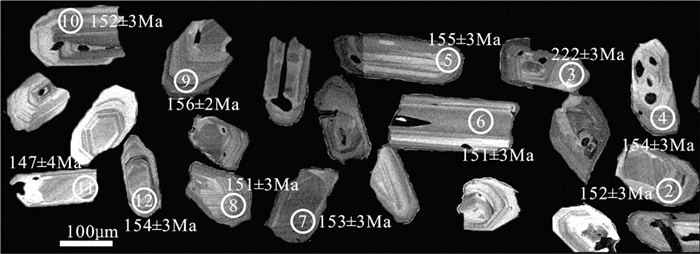
|
图 4 浙东南松阳侏罗系毛弄组流纹质凝灰岩代表性锆石CL图像 Fig. 4 CL images for representive zircons of rhyolitic tuff from the Maonong Formation in Songyang, SE Zhejiang |
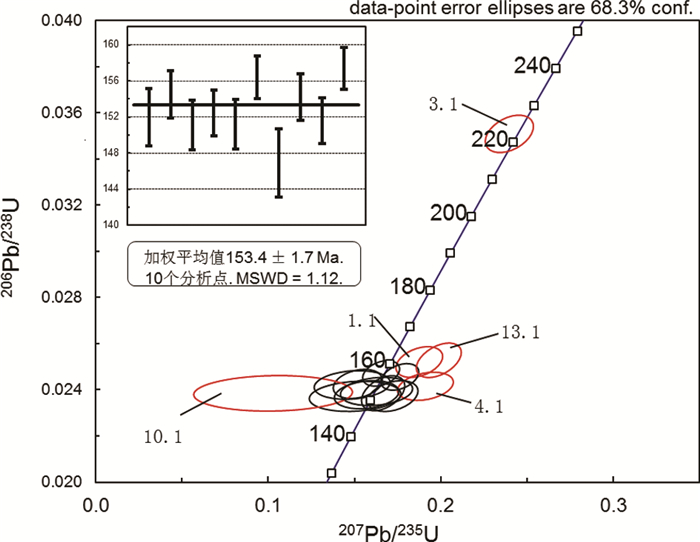
|
图 5 浙东南松阳毛弄组流纹质凝灰岩锆石U-Pb谐和图及加权平均年龄图 Fig. 5 Zircons U-Pb concordian diagram and weighted average ages plots of rhyolitic tuff from the Maonong Formation in Songyang, SE Zhejiang |
近年来研究发现,岩浆的氧逸度、温度与锆石Ce异常存在十分明显的相关关系,而硅含量等对锆石Ce异常影响不大(Trail et al., 2011, 2012; Burnham and Berry, 2012)。因此,通过标定锆石的Ce异常与氧逸度和温度之间的关系,能够较好的测定岩浆的绝对氧逸度。前人通过对La和Pr元素采用几何插值法求得Ce异常(Trail et al., 2011, 2012),但由于La和Pr在锆石中的含量偏低,测试结果常有很大的浮动。Smythe and Brenan (2016)通过研究认为,使用晶格扭曲模型(Blundy and Wood, 1994)可以较好的解决这个问题,这是因为该方法求Ce异常使用的是元素含量更加富集和稳定的稀土元素(Nd-Lu)。在岩浆温度和锆石Ce异常计算结果已知的情况下,可求得153Ma毛弄流纹质凝灰岩、176Ma和169Ma庆元毛弄组火山岩、173Ma政和毛弄组火山岩的氧逸度。LA-ICP-MS锆石微量元素数据和氧逸度计算结果见表 2、表 3、表 4。
|
|
表 2 浙东南松阳毛弄组流纹质凝灰岩LA-ICP-MS锆石微量元素结果(×10-6) Table 2 LA-ICP-MS zircon trace elements results of rhyolitic tuff from the Maonong Formation of Songyang, SE Zhejiang (×10-6) |
|
|
表 3 浙东南庆元毛弄组176Ma英安质凝灰岩(QY-13)和169Ma流纹质凝灰岩(ZX1-3)LA-ICP-MS锆石微量元素结果(×10-6) Table 3 LA-ICP-MS zircon trace elements results of 176Ma dacitic tuff (QY-13) and 169Ma rhyolitic tuff (ZX1-3) from Maonong Formation in Qingyuan, SE Zhejiang (×10-6) |
|
|
表 4 闽北政和173Ma毛弄组流纹质凝灰岩(ZK701)LA-ICP-MS锆石微量元素结果(×10-6) Table 4 LA-ICP-MS zircon trace elements results of 173Ma rhyolitic tuff (ZK701) from Maonong Formation in Zhenghe, northern Fujian (×10-6) |
由锆石Ti温度计计算结果(Ferry and Watson, 2007)可知,毛弄、政和和庆元火山岩、澥浦花岗岩、东南海域花岗岩形成温度总体在600~850℃之间(表 2-表 4)(图 6)。176Ma庆元火山岩、173Ma政和火山岩和178Ma澥浦花岗岩主要落在FMQ(铁橄榄石-磁铁矿-石英)和IW(自然铁-方铁矿)之间(图 6),且氧逸度较低(fO2=-22~-18)。晚三叠世加厚地壳形成的浙东花岗岩也较低,氧逸度总体小于-20(IW以下)(Zhu et al., 2016)。169Ma庆元火山岩、153Ma毛弄流纹质凝灰岩和198~187Ma东南海域花岗岩的氧逸度相对较高,落在FMQ上下(fO2=-18~-13)(图 6)。
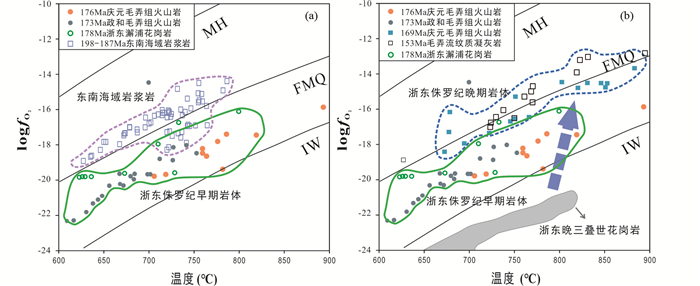
|
图 6 温度-氧逸度图解 (a)浙东侏罗纪早期岩体与东南海域岩浆岩(198~187Ma)氧逸度分布对比图,(b)浙东晚三叠世-侏罗纪早期-侏罗纪晚期氧逸度分布对比图;198~187Ma东南海域花岗岩氧逸度数据引自Xu et al. (2017);178Ma浙东澥浦花岗岩数据、浙东晚三叠世花岗岩氧逸度数据引自Zhu et al.(2013, 2016). IW代表自然铁-方铁矿反应组合; FMQ代表铁橄榄石-磁铁矿-石英反应组合; MH代表磁铁矿-赤铁矿反应组合 Fig. 6 Temperature vs. oxygen fugacity geochemical plots |
本次研究共完成了毛弄组9个火山岩样品的全岩地球化学分析,测试数据结果见表 5。
|
|
表 5 浙东南松阳毛弄组凝灰岩全岩主量元素(wt%)和微量元素(×10-6)分析结果 Table 5 Major elements (wt%) and trace elements (×10-6) results of the tuff from the Maonong Formation in Songyang, SE Zhejiang |
9件样品烧失量变化于2.59%~6.83%,表明火山岩发生了不同程度的矿物次生蚀变。化学性质活泼的大离子亲石元素(如K、Na、Rb、Ba和Sr)的含量可能已经不能代表新鲜的火山岩化学组成,而高场强元素(如Nb、Ta、Zr、Hf和Ti)和稀土元素(REE)则由于化学性质稳定,不容易受到后期低温热液蚀变的影响,可以基本反映原始成分组成,因此我们在讨论中将选用稳定元素进行分析。为避免次生蚀变作用对K2O、Na2O含量所带来的影响,采用相对稳定的高场强元素替代全碱进行岩石分类。结合火山岩(Zr/TiO2)×0.0001-SiO2判别图解和镜下鉴定结果判断(图 7a),松阳毛弄组火山岩主要为180Ma英安质晶屑凝灰岩和153Ma流纹质玻屑凝灰岩两类。在SiO2-K2O图解(图 7b)中,180Ma毛弄英安质晶屑凝灰岩、153Ma流纹质凝灰岩和庆元176Ma英安质和169Ma流纹质凝灰岩落在高钾钙碱性系列中,政和173Ma流纹质凝灰岩落在钾玄岩系列,表明毛弄组火山岩具有高钾的特征。由图 7可知,侏罗纪陆缘火山岩主要为安山岩-英安岩-流纹岩系列及高钾钙碱性系列。
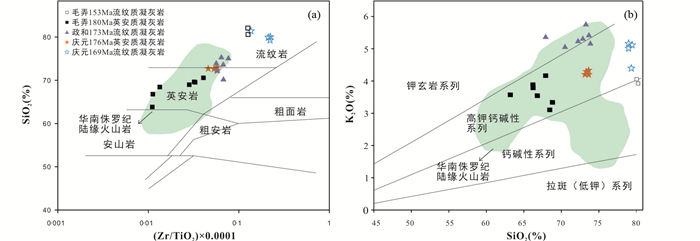
|
图 7 浙东南松阳毛弄组凝灰岩(Zr/TiO2)×0.0001-SiO2判别图解(a, 据Winchester and Floyd, 1977)和SiO2-K2O图解(b, 据Peccerillo and Taylor, 1976) 176Ma和169Ma庆元毛弄组火山岩数据邢新龙(2016);173Ma政和毛弄组火山岩数据李亚楠等(2015);华南侏罗纪陆缘火山岩数据引自Guo et al. (2012), Li et al. (2014), Yan et al. (2016), 陈润生(2015) Fig. 7 The discrimination diagram of (Zr/TiO2)×0.0001 vs. SiO2 (a, after Winchester and Floyd, 1977) and SiO2 vs. K2O (b, after Peccerillo and Taylor, 1976) of the tuff from the Maonong Formation in Songyang, SE Zhejiang |
在微量元素洋脊花岗岩标准化蛛网图中(7b),毛弄英安质、流纹质凝灰岩与其他华南东部侏罗纪陆缘岩浆岩表现出富集K、Rb和Th等大离子亲石元素,相对亏损Nb、Ta、Zr和Hf等高场强元素这一基本特征,和智利火山弧花岗岩相似。华南内陆侏罗纪花岗岩则以富集高场强元素,强烈贫Ba为特征。在球粒陨石标准化稀土元素配分曲线图(图 8a)中,所有样品和华南东部侏罗纪陆缘岩浆岩具有轻稀土元素(LREE)相对富集的稀土元素配分模式,总体呈明显右倾的配分曲线特征,其中153Ma毛弄流纹质玻屑凝灰岩具有显著的Eu负异常(δEu=0.22~0.25),180Ma毛弄英安质晶屑凝灰岩具有弱Eu负异常(δEu=0.66~0.75)。而华南内陆侏罗纪花岗岩则有着明显高的REE值和显著的Eu负异常且轻重稀土分馏不明显,总体呈平坦的“海鸥式”配分曲线特征。

|
图 8 浙东南松阳毛弄组凝灰岩球粒陨石标准化稀土元素图解(a, 标准化值据Sun and McDonough, 1989)和洋脊花岗岩标准化微量元素蛛网图(b, 标准化值据Pearce et al., 1984) 智利火山弧花岗岩数据引自Pearce et al. (1984);176Ma和169Ma庆元毛弄组火山岩数据邢新龙(2016);华南侏罗纪陆缘岩浆岩数据引自Yui et al. (2009),Liu et al. (2012b),Guo et al. (2012),Li et al.(2013a, b, 2014, 2016a, b),Wang et al.(2015, 2016),Yan et al. (2016),Zhu et al. (2016),Xu et al.(2016a, 2017),Yuan et al. (2018),周旋和于津海(2011),葛小月(2003),邱检生等(2004),刘潜等(2011),陈润生(2015);华南侏罗纪内陆花岗岩数据引自Li et al. (2003),He et al. (2010),Yu et al. (2010),Ye et al. (2013),Jiang et al. (2015),邓平等(2004),付建明等(2005),柏道远等(2005),朱金初等(2006) Fig. 8 Chondrite-normalized REE diagrams (a, normalization values after Sun and McDonough, 1989) and ORG-normalized incompatible elements spidergrams (b, normalization values after Pearce et al., 1984) of the tuff from the Maonong Formation in Songyang, SE Zhejiang |
毛弄组凝灰岩5个样品全岩Sr-Nd同位素分析数据陈列在表 6中。数据结果表现出不同的初始Sr同位素比值,英安质和流纹质凝灰岩差别明显,分别为0.6887~0.6912和0.7086~0.7087。鉴于毛弄流纹质凝灰岩的87Rb/86Sr比大于7.5,所以不适合用其做(87Sr/86Sr)i相关讨论分析(Wu et al., 2002)。但所有的样品的εNd(t)值在-7.59~-6.26之间,且表现出了较一致的tDM2年龄,在1.36~1.49Ga之间。
|
|
表 6 浙东南松阳毛弄组凝灰岩Nd和Sr同位素组成 Table 6 Nd-Sr isotope compositions of the tuff from the Maonong Formation in Songyang, SE Zhejiang |
近年来大量的年代学工作表明,原划分为晚侏罗世的磨石山群应划归下白垩统(汪庆华, 2001; 邢光福等, 2004; 顾知微, 2005)。因此,侏罗系在华南东北部的分布和记录有限,其中,浙东南松阳毛弄组是华南东北部地区为数不多被确认的侏罗纪地层记录之一。区域地质调查研究表明,毛弄组岩性定义为一套灰绿色英安质玻屑晶屑凝灰岩、砂岩为主的岩石组合,古生物化石指示其形成时代为中侏罗世(浙江省地质矿产局, 1989)。
陈荣等(2007)通过对松阳毛弄组英安质晶屑凝灰岩进行SHRIMP锆石U-Pb定年,首先获得毛弄组下段火山岩年龄为180±4Ma,Liu et al. (2012a)在该剖面下段测得的英安质凝灰岩年龄相似,为177±1Ma。邢新龙(2016)在浙东南庆元地区发现毛弄组英安质和流纹质凝灰岩,锆石U-Pb年龄分别为176±1Ma和169±3Ma。而在浙闽交界地区,李亚楠等(2015)在福建政和铁山发现中侏罗世流纹质凝灰岩,锆石U-Pb年龄为173±1Ma。这些研究将广义上的毛弄组时代下限至少限定在早侏罗世晚期。
本次研究在毛弄组下段上部获得的流纹质玻屑凝灰岩的SHRIMP锆石U-Pb年龄为153±2Ma,这一结果与陈荣(2007)在同一剖面上测试的样品,无论是岩性还是年龄都有所差别,表明毛弄组火山岩可能为多期喷发的产物。但由于本区地表植被覆盖严重,要搞清楚不同岩性火山岩之间的接触关系仍需要在今后开展更为深入的野外地质调查。值得注意的是,王加恩等(2015)在浙江云和坑口和南坑测得毛弄组晶屑和玻屑凝灰岩的锆石U-Pb年龄分别为155±5Ma(SHRIMP)和152±7Ma(LA-ICP-MS)。闽北政和发现的晚侏罗世流纹质晶屑凝灰岩和碎斑熔岩锆石U-Pb年龄分别为150Ma和148Ma(林敏, 2013)。这些证据表明区域上存在同期的岩浆事件,本区侏罗纪火山岩形成时代已延伸至晚侏罗世。
总之,毛弄组火山岩主要由英安质凝灰岩和流纹质凝灰岩两套岩性组成。基于目前已有的测年结果,本文认为浙东南及邻区毛弄组中火山岩的时代主要介于180~148Ma,可能由多期侏罗纪火山喷发形成。
5.2 毛弄组火山岩形成环境 5.2.1 源区特征毛弄组火山岩有着不同程度的Eu负异常和Sr、Ba值,反映了不同的长石分异程度(不同程度的斜长石源区残留或分离结晶)(图 9a)。而斜长石和钾长石的分离结晶会提高La、Nb等不相容元素的含量(Guo et al., 2012),但SiO2的增加并没有导致这些不相容元素(总体或各部分)的明显提升(图 9c-f),表明结晶分离作用在岩浆演化过程中可能处于更次要的地位,源区更可能有一定程度的斜长石残留。
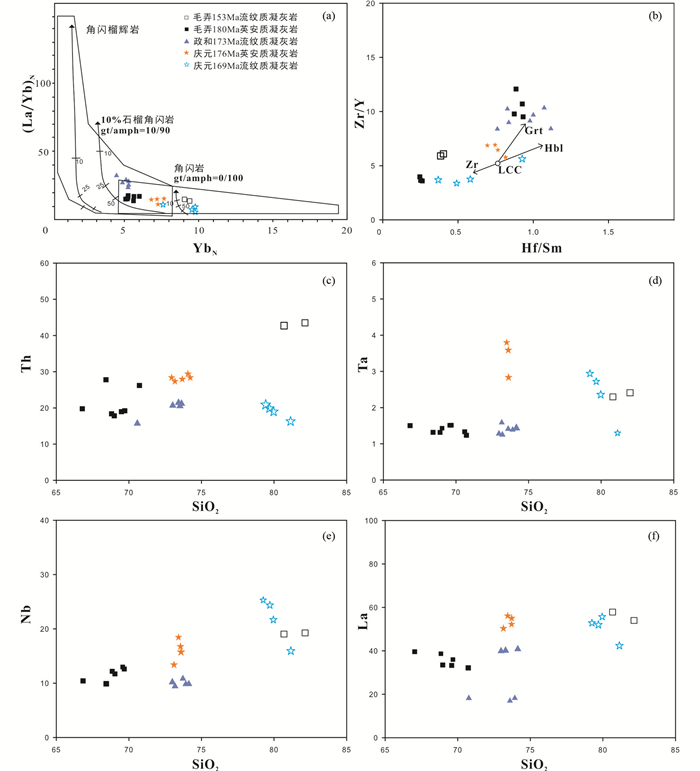
|
图 9 毛弄组火山岩YbN-(La/ Yb)N(a)、Hf/Sm-Zr/Y图解(b)及SiO2-不相容元素图解(图c-f) 箭矢量代表部分熔融和结晶分异的增长趋势效应,用于解释潜在的残余相组合.LCC值(下地壳平均值)和分配模式箭矢量图引自Li et al. (2016a),庆元火山岩数据邢新龙(2016),政和火山岩数据李亚楠等(2015) Fig. 9 YbN vs. (La/Yb)N plot (a), Hf/Sm vs. Zr/Y plot (b) and SiO2 vs. selected trace element diagrams (c-f) of volcanic rocks from the Maonong Formation Vector arrows show the effect of increasing degrees of partial melting and fractionation for constraining the possible residual assemblage during melting. Values of the average LCC (lower continental crust) and vector arrows diagram are from Li et al. (2016a), Qingyuan volcanic rocks are from Xing (2016), Zhenghe volcanic rocks are from Li et al. (2015) |
180Ma毛弄、176Ma庆元和173Ma政和毛弄组凝灰岩有着较高的(La/Yb)N比值(均值22.95),明显高于华南东部上地壳(10.76, 鄢明才等, 1997),且有着较低的Yb(1.2×10-6~1.9×10-6)和Y(12.5×10-6~20.1×10-6)含量和Eu的负异常。而这些特征不应由华夏陆块基底地壳的本身成分特征导致(Yu et al., 2009; Xia et al., 2012),说明源区部分熔融可能受到了石榴子石的控制(Rapp and Watson, 1995)。不过,该火山岩低Sr(< 400×10-6)及Sr/Y比值(均值20.7)的特征并不同于埃达克岩(Defant and Drummond, 1990; Defant et al., 2002; Rapp et al., 1999),且其Nb/Ta比较低(< 13),表明源区不含金红石,源区深度应不超过45km(Xiong et al., 2006; Ma et al., 2013)。这些特征表明这些火山岩的源区残留相组合可能为“斜长石+石榴石+角闪石”。153Ma毛弄和169Ma庆元流纹质凝灰岩具有显著的Eu负异常和低Sr值及较低的(La/Yb)N比值,相对较高的Yb(均值2.30×10-6)和Y(均值21.8×10-6)值,说明残留相中可能有斜长石和(或)角闪石存在。根据Zr/Y-Hf/Sm图解简单推断(图 9b)(Li et al., 2016a),角闪石残留相可能对于180Ma毛弄、176Ma庆元和173Ma政和毛弄组凝灰岩有着一定影响,而153Ma毛弄和169Ma庆元流纹质凝灰岩则可能需要角闪石的脱水熔融。
加厚地壳底部在P=1.5~2.0GPa时的残余矿物组合为“斜长石+石榴石+角闪石”且熔体出现弱负Eu异常,而陆壳岩石在正常地壳厚度或加厚地壳中上部(< 30km)将产生具有(显著)负Eu异常的流纹质(花岗质)岩浆(Wyllie et al., 1984; Deng et al., 2004)。浙东地区在晚三叠世时期处于地壳加厚阶段(Zhu et al., 2013, 2016),而174Ma浙东南近海TTG岩石组合的发现也可能指示了此时浙东继承了较大的地壳厚度(Yuan et al., 2018)。据此可以推测,毛弄、庆元和政和等侏罗纪早期毛弄组火山岩可能起源于相对较厚的地壳下部,而153Ma毛弄和169Ma庆元流纹质凝灰岩的源区组成特征表明其源区可能为相对较浅的地壳深度(如有斜长石残余的角闪岩相)。
毛弄英安质凝灰岩表现出与华夏陆块古元古代基底地壳相似的Sr-Nd同位素组成(图 10c),表明它们可能主要形成于华夏陆块基底地壳物质的部分熔融,但相对于古元古代华夏陆块基底,毛弄组样品有着相对年轻的Nd同位素tDM2年龄(1.36~1.49Ga、表 6),且区域上也没有对应的岩浆事件可以解释这一年龄,反映可能有少量新生地幔物质的加入(Yu et al., 2009)。如用二元混合模式计算(Langmuir et al., 1978),简单假设混合的新生物质端元为类似MORB的Sr-Nd同位素组成,而地壳物质岩浆端元为华夏基底地壳熔融形成的同期邻近的189Ma光泽花岗岩的Sr-Nd同位素组成(Yu et al., 2009; Jiang et al., 2015; 刘昌实和陈繁荣, 1991),则形成毛弄英安质凝灰岩至少需要混入15%的亏损幔源(图 10c)。毛弄英安质凝灰岩的Hf同位素特征(εHf(t)=-15~-12)也指示了少量新生物质的参与,与幔源新生物质计算结果大致相符(图 10a)。153Ma毛弄流纹质凝灰岩较年轻的Nd模式年龄(约1.4Ga)也可能由部分新生物质的加入导致。结合晚侏罗世浙东花岗岩的Hf同位素特征(εHf(t)=-11~-2),可以推测晚侏罗世浙东地区也可能有着一定新生物质的参与(贾德龙等, 2013; 张建芳等, 2013; 高万里, 2014; 王对兴等, 2015)。
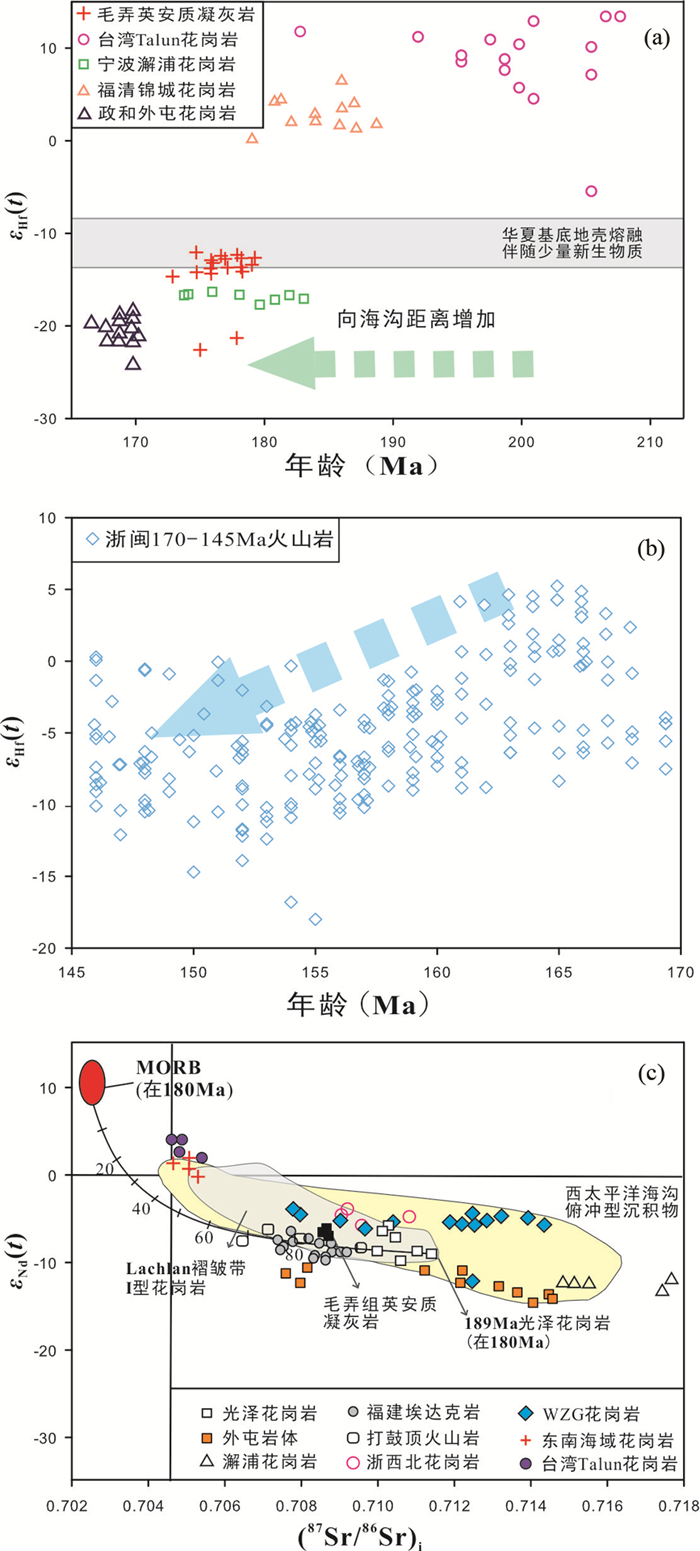
|
图 10 华南东部陆缘侏罗纪早期岩浆岩(a)和浙闽侏罗纪晚期火山岩(b)U-Pb年龄-锆石εHf(t)值对比图及华南东部陆缘侏罗纪岩浆岩εNd(t)-(87Sr/86Sr)i对比图(c) 侏罗纪早期陆缘岩浆岩Hf同位素数据来源:毛弄(Liu et al., 2012a),台湾Talun (Yui et al., 2017),澥浦(Zhu et al., 2016),锦城(刘潜等, 2011),外屯(Wang et al., 2016);浙闽侏罗纪晚期火山岩Hf同位素数据引自Guo et al. (2012),Li et al. (2016a),Liu et al. (2016),Yan et al. (2016);陆缘岩浆岩Sr-Nd同位素数据引自Li et al.(2013a, b, 2016a, b),Jiang et al. (2015),Wang et al.(2015, 2016),Yui et al. (2017),Zhu et al. (2016),Yan et al. (2016),Xu et al. (2017);西太平洋俯冲型沉积物范围引自Li et al. (2013a);澳大利亚Lachlan褶皱带Ⅰ型花岗岩区域引自McCulloch and Chappell (1982) Fig. 10 Comparison diagram of zircon U-Pb ages vs. zircon εHf(t) for the magmatic rocks in the early stage of Jurassic in the continental margin of ESCB (a) and for the volcanic rocks in the later stage of Jurassic in Zhejiang-Fujian (b), comparison diagram of εNd(t) vs. (87Sr/86Sr)i for the magmatic rocks in the Jurassic margin of ESCB (c) |
总之,毛弄组火山岩主要起源于华夏陆块基底地壳物质的部分熔融,并有少量地幔新生物质的加入。毛弄英安质火山岩等侏罗纪早期毛弄组火山岩可能起源于相对较厚的地壳下部,而毛弄流纹质凝灰岩等侏罗纪晚期毛弄组火山岩的源区则可能处于相对较浅的地壳深度。
5.2.2 构造背景分析安第斯型陆缘发育了大陆岩浆弧,而西太平洋型陆缘则发育了岛弧岩浆弧(Ramos, 1999)。西南太平洋陆缘自晚泥盆世发育了安第斯型活动陆缘,到中白垩世转换为西太平洋型陆缘(Li and Powell, 2001; Li et al., 2012),所以许多学者推测在西太平洋北部,从三叠纪到中白垩世也存在这样一个安第斯型岩浆弧(Jahn et al., 1990; Zhou and Li, 2000; Li et al., 2012; Dong et al., 2015)。
区别于华南内陆同期铁质的板内花岗岩,侏罗纪陆缘火山-侵入岩主要为镁质,同时主要落在科迪勒拉钙碱性花岗岩区域中(图 11),表明其形成背景可能更接近于安第斯型的俯冲环境(Whalen et al., 1987; Frost et al., 2001; Li et al., 2012)。松阳毛弄组火山岩虽然风化程度不同,但没有明显特征差异,与其他区域(庆元和政和)的毛弄组火山岩落在相似区域,表明风化应不影响其镁质钙碱性的基本特征。此外,毛弄组火山岩和其它华南东部陆缘岩浆岩的微量元素特征与华南内陆花岗岩相区别,而与智利安第斯型火山弧花岗岩特征相似(图 8b),表明毛弄组火山岩等镁质钙碱性陆缘岩浆岩可能并非形成于板内岩浆作用,而与弧岩浆作用有关。

|
图 11 FeOT/(FeOT+MgO)-SiO2 (a)和(Na2O+K2O-CaO)-SiO2 (b)图解(据Frost et al., 2001) 华南侏罗纪陆缘花岗岩数据引自Yui et al. (2009),Liu et al. (2012b),Li et al.(2013a, b, 2016a, b),Wang et al.(2015, 2016),Zhu et al. (2016),Xu et al.(2016a, 2017),Yuan et al. (2018),葛小月(2003),邱检生等(2004),刘潜等(2011);华南侏罗纪陆缘火山岩数据引自Guo et al. (2012),Li et al. (2014),Yan et al. (2016),陈润生(2015);华南侏罗纪内陆花岗岩数据引自Li et al. (2003),He et al. (2010),Yu et al. (2010),Ye et al. (2013),Jiang et al. (2015),邓平等(2004),付建明等(2005),柏道远等(2005),朱金初等(2006) Fig. 11 FeOT/(FeOT+MgO) vs. SiO2 (a) and (Na2O+K2O-CaO) vs. SiO2 (b) geochemical plots (after Frost et al., 2001) |
在岩性组合方面。毛弄组火山岩等侏罗纪陆缘岩浆岩基本落入I和S型花岗岩区域中(图 12),同时也与Lachlan褶皱带Ⅰ型花岗岩有着相似的Sr-Nd同位素组成(图 10c)。综合前人研究表明,侏罗纪华南东部陆缘岩浆岩主要为Ⅰ型(Li et al., 2012; Wang et al., 2016; Xu et al., 2016a, 2017; Yuan et al., 2018),而华南内陆侏罗纪早期花岗岩主要为A型(图 12)(Zhou et al., 2006; He et al., 2010; Zhu et al., 2010; Ye et al., 2013)。华南内陆地区侏罗纪岩浆作用可分为两个阶段(Li et al., 2007):侏罗纪早期岩浆岩(195~165Ma)主要为双峰式火山岩和A型花岗岩、玄武岩组合(Li et al., 2007; He et al., 2010; Zhu et al., 2010; Yu et al., 2010; Huang et al., 2011);晚期(165~145Ma)则为高分异Ⅰ型花岗岩和少量A型花岗岩、正长岩、玄武岩的岩石组合,缺乏中-酸性火山岩(Li et al., 2007; Jiang et al., 2009)。而在沿海等邻近俯冲带地区,侏罗纪岩浆岩以镁质钙碱性和Ⅰ型花岗(火山)岩为主,而镁质钙碱性特征和Ⅰ型花岗岩往往与俯冲环境有关(Osborn, 1979; Whalen et al., 1987; Frost et al., 2001)。同时却缺乏内陆地区普遍的A型花岗岩或双峰式火山岩、玄武岩等代表伸展背景的岩石组合。这些岩石特征及其组合特点的差异表明华南东部陆缘在侏罗纪可能受控于俯冲作用的影响与改造,而非陆内伸展或板内裂谷作用。
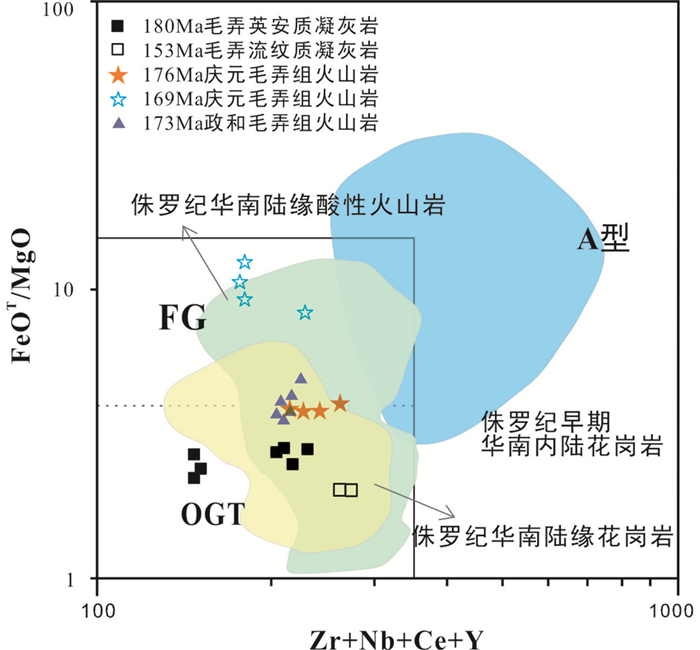
|
图 12 (Zr+Nb+Ce+Y)-FeOT/MgO图解 侏罗纪早期华南内陆花岗岩数据引自Li et al. (2003),He et al. (2010),Yu et al. (2010),Ye et al. (2013),Jiang et al. (2015),邓平等(2004);庆元和政和毛弄组火山岩、华南侏罗纪陆缘花岗岩、火山岩数据引用同上 Fig. 12 Zr+Nb+Ce+Y vs. FeOT/MgO geochemical plots |
陆缘岩体较低的源区温度(< 800℃,图 6)也与陆内伸展作用相区别,因为以南岭岩体为代表的陆内伸展作用往往需要很高的熔融温度(Roger and Greenberg, 1990; Eby, 1992)。在构造背景判别图中(图 13),区别于同期内陆岩浆岩以板内型为主的特征,这些钙碱性陆缘火山-侵入岩主要投影于火山弧型与同碰撞型区域,进一步指示了陆缘岩浆岩的形成环境为陆缘弧造山背景。毛弄英安质凝灰岩等侏罗纪陆缘岩浆岩的Sr-Nd同位素特征与西太平洋海沟俯冲沉积物相似(图 10c),也表明侏罗纪陆缘岩浆岩形成的环境可能与西太平洋俯冲环境有关。总之,这些低温的侏罗纪弧相关岩浆岩构成了一个北东向的陆缘弧岩浆岩带。而陆缘岩浆岩落在壳幔两端元之间较大范围(图 10c),总体上反映了在俯冲背景下地幔物质可能在不同程度上参与了陆缘侏罗纪岩浆岩的形成过程。
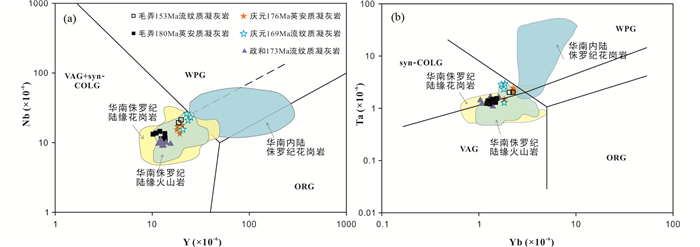
|
图 13 Y-Nb构造判别图(a)和Yb-Ta构造判别图(b)(据Pearce et al., 1984) VAG:火山弧型;Syn-COLG:同碰撞型;WPG:板内型;ORG:洋脊型.华南侏罗纪陆缘花岗岩、火山岩数据、内陆花岗岩数据引用同上 Fig. 13 Y vs. Nb (a) and Yb vs. Ta (b) discrimination diagrams of tectonic setting (after Pearce et al., 1984) VAG: volcanic arc granite; Syn-COLG: syn-collision granite; WPG: within plate granite; ORG: ocean-ridge granite |
综上所述,毛弄组火山岩等陆缘岩浆岩形成于安第斯型弧岩浆作用背景。在侏罗纪华南东部陆缘可能发育一个与古太平洋俯冲有关的“安第斯型”陆缘岩浆弧,其时代最早可以追溯到早侏罗世早期,并持续到晚侏罗世。
5.3 华南东部安第斯型陆缘弧的演化锆石对于酸性岩浆来说是最早结晶的矿物之一,类似锆石氧同位素,锆石中的微量元素应不随后期岩浆作用发生明显改变,其反演的岩浆氧逸度因而接近母岩浆的氧逸度。华南东部侏罗纪陆缘岩浆岩的氧逸度在时空上有着明显的变化。从空间上看,176Ma庆元火山岩、173Ma政和火山岩和178Ma澥浦花岗岩落在FMQ和IW之间,氧逸度fO2较低(< -18),而同期东南海域花岗岩落在FMQ上下,氧逸度fO2较高(-18~-14)(图 6a)。这一氧逸度特征的差异表明在早侏罗世,东南海域岩体岩浆源区可能有着比大陆陆缘的岩浆岩更高的氧逸度。从时间上看,晚三叠世浙东花岗岩的氧逸度低(IW以下)。早侏罗世陆缘岩浆岩则落在FMQ和IW之间(图 6b),表明浙东早侏罗世岩体源区可能继承了晚三叠世的低氧逸度环境,但氧逸度相对有所提升(图 6b)。而169Ma庆元火山岩和153Ma毛弄流纹质凝灰岩的氧逸度进一步上升,落在FMQ上下(fO2=-18~-13)。从晚三叠世到晚侏罗世,浙东花岗岩的氧逸度呈现出不断上升的趋势。综合时空上氧逸度的变化特征,我们可以推测陆缘地区俯冲流体的影响可能有着从东南海域向大陆陆缘扩散的趋势,使得浙东岩浆岩源区获得相对上升的氧逸度条件。
侏罗纪的弧岩浆作用可能存在着两期。在古太平洋俯冲的初始阶段(205~170Ma),陆缘弧岩浆作用主要存在于陆缘海域和台湾等近海沟地区,形成东南海域(花岗)闪长岩和Talun等花岗岩(Yui et al., 2017; Xu et al., 2017; 刘潜等, 2011; 杨文达等, 2010; 郭真等, 2015)。这些早侏罗世岩体主要为俯冲背景下幔源熔体演化的产物(Liu et al., 2012b; Yui et al., 2017; Xu et al., 2017),且带有富水、氧化的俯冲带源区特征。这一时期,大陆陆缘地区仅发育澥浦花岗岩和毛弄组火山岩。从东南海域到大陆陆缘岩浆岩Hf同位素的演变特征反映了一个向内陆幔源新生物质的递减过程(图 10a),表明俯冲作用影响可能由东南海域向大陆陆缘减弱。浙闽地区此时受俯冲作用的影响可能较小,其岩浆岩主要形成于地壳物质的熔融,新生地幔物质参与较少。结合大陆陆缘上的岩浆岩相对于东南海域较低的氧逸度,进一步表明俯冲作用对浙闽地区的影响可能相对较弱(图 6a)。
随着古太平洋俯冲作用的持续影响(170~145Ma),陆缘地区发育了更大规模的岩浆活动(Li et al., 2016a, b; Liu et al., 2016; 陈润生, 2015; 邢新龙, 2016),火山岩岩性以安山质-英安质-流纹质为主,主要分布在政和-大埔断裂带以东地区,更为广泛的岩浆活动反映了俯冲影响的扩大或俯冲地幔物质的更大参与。这些火山-侵入岩具有相对较高的εHf(t)值(Guo et al., 2012; Li et al., 2016b; Liu et al., 2016),进一步指示了壳幔耦合的增强。且这期火山岩具有更高的氧逸度(图 6b),而氧逸度的抬升也可能代表着更大范围的俯冲流体影响。Zhang et al. (2017)通过对中侏罗世德兴岩体的研究同样认为,这一时期氧逸度的抬升受控于侏罗纪俯冲洋壳所释放的流体的影响。
综上所述,华南东部侏罗纪陆缘弧岩浆作用可能存在两期:前期陆缘弧岩浆作用主要存在于陆缘海域和台湾等近海沟地区,大陆陆缘或浙闽地区此时受俯冲作用的影响可能较小。后期随着古太平洋俯冲作用的影响进一步扩大,大陆陆缘地区有着更大范围的俯冲流体影响并发育了更大规模的岩浆活动。
5.4 华南东部侏罗纪构造体制的时空差异在华南东部内陆地区,伸展性质的岩浆岩组合和断陷-裂谷盆地代表了内陆地区在侏罗纪的陆内伸展作用(Zhou et al., 2006; Shu et al., 2009; Huang et al., 2011; Cen et al., 2016)。但另一些学者认为华南东部陆缘的沉积-构造-岩浆特征显然记录了一次挤压造山事件(Xiao and He, 2005; Li et al., 2013b; Dong et al., 2015; 邢光福等, 2008)。但这些差异又是否代表着华南东部陆缘与内陆在侏罗纪有着不一样的构造背景?
前人和本文对于陆缘岩浆岩的研究结果表明,毛弄组火山岩等陆缘岩浆岩的形成与古太平洋俯冲相关的陆缘岩浆作用有关(Li et al., 2012; Yui et al., 2017; Dong et al., 2015; Xu et al., 2017; Yuan et al., 2018)。同时,TTG岩石组合和埃达克质岩体的发现则表明华南东部陆缘在侏罗纪可能经历了某种程度的地壳增厚(Wang et al., 2015, 2016; Li et al., 2016a, b; Yuan et al., 2018; 冯艳芳等, 2014),使得侏罗纪陆缘地区可能有着大于50km的地壳厚度(Sen and Dunn, 1994)和显著的地壳剥蚀速率(黎敦朋等, 2014),从而明显区别于内陆地区地壳的伸展减薄。这一区域隆升事件也为许多沉积-构造证据所记录:沉积上,在侏罗纪,陆缘盆地向山前快速沉积充填环境转变,且物源指向东部陆缘(Li et al., 2012; Hu et al., 2015; Shen et al., 2016; 舒良树等, 2011);构造上,东南沿海侏罗系发育了广泛的褶皱变形、推覆构造和变质作用(Chen et al., 2004; Xiao and He, 2005; Dong et al., 2015; 邢光福等, 2008),如在长乐-南澳变质带的强烈变质变形作用(Cui et al., 2013; 冯艳芳等, 2014)。
华南东部白垩纪火山岩Hf同位素表现出了从富集到亏损的规律,反映了壳幔耦合的加剧或幔源岩浆物质比重的持续增加,也间接指示了伸展作用的增强(Guo et al., 2012; Liu et al., 2016)。不同的是,在中-晚侏罗世,浙闽地区火山岩虽然整体有着比早侏罗世更为明显的地幔物质参与,但却表现出了与白垩纪火山岩相反的Hf同位素演化规律(图 10b),这些变化说明新生物质在侏罗纪总体有着逐渐减少的趋势。既然新生物质的贡献程度间接反映了地壳压力状态的变化(Lapierre et al., 1997; Zhou and Li, 2000),那么新生物质的减少表明侏罗纪陆缘与白垩纪不断发展的弧后伸展不同,地壳可能存在着持续挤压的状态,这样一个挤压状态和新生物质递减的构造环境无疑限制了大规模岩浆作用的产生和发展。相对于白垩纪以来弧后伸展形成的花岗岩,中国东部侏罗纪的俯冲型花岗岩规模较小(Wu et al., 2005),同样表明以挤压为主的构造环境既不利于大量地壳物质的部分熔融及岩浆上升,也不利于强烈的壳幔物质交换(肖庆辉等, 2002)。
但近年来在东南海域和大陆陆缘上不断发现的侏罗纪弧岩浆岩表明,在华南东部陆缘同样有着一定规模的弧岩浆作用,并非原本定义的微弱或间断。在侏罗纪,东南海域可能发育了更为显著的弧岩浆作用:(1)火山岩(包括安山岩)主要分布在海岸地带可能指示了海域对弧岩浆岩的覆盖;(2)从西菲律宾、台湾等地俯冲增生杂岩带的发育(Wakita and Metcalfe, 2005; Zamoras et al., 2008);(3)东南海域侏罗纪弧岩浆岩的不断发现(Xu et al., 2016a, 2017; Yuan et al., 2018; 杨文达等, 2010)。对于大陆陆缘地区,虽然同期也受到俯冲带地幔岩浆上涌的影响,但可能由于离俯冲带较远,处于挤压体制下等因素,使得浙闽地区火山活动的发育受到限制。
综上所述,中生代构造活动在时空上和方式上存在着明显差异性,在侏罗纪华南东部内陆地区由挤压向伸展环境转换,而在东部陆缘在侏罗纪仍然处于安第斯型陆缘背景下的挤压造山环境,向伸展背景的转变至早白垩世才开始。
6 结论(1) 毛弄组火山岩主要由英安质凝灰岩和流纹质凝灰岩两套岩性组成,本次研究在毛弄组下段获得的流纹质玻屑凝灰岩的SHRIMP锆石U-Pb年龄为153±2Ma,为晚侏罗世。基于目前已有的测年结果,毛弄组火山岩的时代主要介于180~148Ma之间,可能由多期侏罗纪火山喷发形成。
(2) 毛弄组火山岩属于镁质钙碱性和Ⅰ型花岗(火山)岩系列,表现出明显的轻稀土元素富集的稀土配分曲线特征,其中早侏罗世英安质凝灰岩Eu负异常不明显,而晚侏罗世流纹质凝灰岩具有显著的Eu负异常;两期火山岩均富集K、Rb、Th等大离子亲石元素,亏损Nb、Ta、Zr和Hf等高场强元素。
(3) 毛弄组火山岩起源于华夏陆块古元古代基底地壳物质的部分熔融,并有部分地幔新生物质的加入,但可能来自不同的地壳深度。毛弄组火山岩等陆缘岩浆岩形成于安第斯型弧岩浆作用背景。
(4) 早侏罗世东南海域岩浆岩的氧逸度比大陆陆缘更高,且大陆陆缘岩浆岩的氧逸度从晚三叠世至晚侏罗世不断升高,可能表明陆缘地区俯冲流体的影响有着从东南海域向大陆陆缘扩散的趋势。
(5) 华南东部侏罗纪陆缘可能发育一个与古太平洋俯冲有关的“安第斯型”陆缘岩浆弧,其时代可能最早可以追溯到早侏罗世早期,并持续扩大到中-晚侏罗世。这一时期陆缘总体处于相对挤压的构造环境,与同期内陆地区板内伸展背景形成鲜明对比。
致谢 南京地质调查院邢光福老师和李亚楠工程师提供了庆元和政和地区火山岩锆石微量元素数据,福建省地质调查研究院的陈润生总工提供了部分地球化学数据。浙江大学黄伟康、李春阳、陈林燊等硕士研究生在野外工作和样品处理方面提供了帮助。合肥工业大学李全忠老师在锆石LA-ICP-MS锆石微量元素实验方面给予了热情的指导。两位审稿人提出了重要而又富有建设性的修改意见和建议,显著提升了本文的质量。在此对他们表示衷心的感谢!
Ames L, Tilton GR and Zhou GZ. 1993. Timing of collision of the Sino-Korean and Yangtse cratons: U-Pb zircon dating of coesite-bearing eclogites. Geology, 21(4): 339-342. DOI:10.1130/0091-7613(1993)021<0339:TOCOTS>2.3.CO;2 |
Bai DY, Chen JC, Ma TQ and Wang XH. 2005. Geochemical characteristics and tectonic setting of Qitianling A-type granitic pluton in Southeast Hunan. Acta Petrologica et Mineralogica, 24(4): 255-272. |
Belousova E, Griffin W, O'Reilly SY and Fisher N. 2002. Igneous zircon: Trace element composition as an indicator of source rock type. Contributions to Mineralogy and Petrology, 143(5): 602-622. DOI:10.1007/s00410-002-0364-7 |
Blundy J and Wood B. 1994. Prediction of crystal-melt partition coefficients from elastic moduli. Nature, 372(6505): 452-454. DOI:10.1038/372452a0 |
Bureau of Geology and Mineral Resources of Fujian Province. 1985. Regional Geology of Fujian Province. Beijing: Geological Publishing House: 134-151.
|
Bureau of Geology and Mineral Resource of Guangdong Province. 1988. Regional Geology of Guangdong Province. Beijing: Geological Publishing House: 192-213.
|
Bureau of Geology and Mineral Resources of Zhejiang Province (BGMRZ). 1989. Regional Geology of Zhejiang Province. Beijing: Geological Publishing House, 131-188, 344-387 (in Chinese)
|
Burnham AD and Berry AJ. 2012. An experimental study of trace element partitioning between zircon and melt as a function of oxygen fugacity. Geochimica et Cosmochimica Acta, 95: 196-212. DOI:10.1016/j.gca.2012.07.034 |
Cen T, Li WX, Wang XC, Pang CJ, Li ZX, Xing GF, Zhao XL and Tao JH. 2016. Petrogenesis of Early Jurassic basalts in southern Jiangxi Province, South China: Implications for the thermal state of the Mesozoic mantle beneath South China. Lithos, 256-257: 311-330. DOI:10.1016/j.lithos.2016.03.022 |
Charvet J. 2013. The Neoproterozoic-Early Paleozoic tectonic evolution of the South China block: An overview. Journal of Asian Earth Sciences, 74: 198-209. DOI:10.1016/j.jseaes.2013.02.015 |
Chen CH, Lin W, Lan CY and Lee CY. 2004. Geochemical, Sr and Nd isotopic characteristics and tectonic implications for three stages of igneous rock in the Late Yanshanian (Cretaceous) orogeny, SE China. Earth and Environmental Science Transactions of the Royal Society of Edinburgh, 95(1-2): 237-248. DOI:10.1017/S0263593300001048 |
Chen CH, Lee CY and Shinjo R. 2008. Was there Jurassic paleo-Pacific subduction in South China? Constraints from 40Ar/39Ar dating, elemental and Sr-Nd-Pb isotopic geochemistry of the Mesozoic basalts. Lithos, 106(1-2): 83-92. DOI:10.1016/j.lithos.2008.06.009 |
Chen R, Xing GF, Yang ZL, Zhou YZ, Yu MG and Li LM. 2007. Early Jurassic zircon SHRIMP U-Pb age of the dacitic volcanic rocks in the southeastern Zhejiang Province determined firstly and its geological significances. Geological Review, 53(1): 31-35. |
Chen RS. 2015. The petrogeochemical characteristics and petrogenesis of Early Mesozoic volcanic rocks, Fujian Province. Geology of Fujian, 34(1): 1-16. |
Cui JJ, Zhang YQ, Dong SW, Jahn BM, Xu XB and Ma LC. 2013. Zircon U-Pb geochronology of the Mesozoic metamorphic rocks and granitoids in the coastal tectonic zone of SE China: Constraints on the timing of Late Mesozoic orogeny. Journal of Asian Earth Sciences, 62: 237-252. DOI:10.1016/j.jseaes.2012.09.014 |
Defant MJ and Drummond MS. 1990. Derivation of some modern arc magmas by melting of young subducted lithosphere. Nature, 347(6294): 662-665. DOI:10.1038/347662a0 |
Defant MJ, Xu JF, Kepezhinskas P, Wang Q, Zhang Q and Xiao L. 2002. Adakites: Some variations on a theme. Acta Petrologica Sinica, 18(2): 129-142. |
Deng P, Shu LS, Yu XQ, Wang B, Tan ZZ and Sun Y. 2004. Early-Middle Jurassic basins and features of igneous rocks in the western Fujian-southern Jiangxi region. Acta Petrologica Sinica, 20(3): 521-532. |
Dong SW, Zhang YQ, Chen XH, Long CX, Wang T, Yang ZY and Hu JM. 2008. The Formation and deformational characteristics of East Asia multi-direction convergent tectonic system in Late Jurassic. Acta Geoscientica Sinica, 29(3): 306-317. |
Dong SW, Zhang YQ, Zhang FQ, Cui JJ, Chen XH, Zhang SH, Miao LC, Li JH, Shi W, Li ZH, Huang SQ and Li HL. 2015. Late Jurassic-Early cretaceous continental convergence and intracontinental orogenesis in East Asia: A synthesis of the Yanshan revolution. Journal of Asian Earth Sciences, 114: 750-770. DOI:10.1016/j.jseaes.2015.08.011 |
Dong YP, Zhang GW, Neubauer F, Liu XM, Genser J and Hauzenberger C. 2011. Tectonic evolution of the Qinling orogen, China: Review and synthesis. Journal of Asian Earth Sciences, 41(3): 213-237. DOI:10.1016/j.jseaes.2011.03.002 |
Dong YP, Liu XM, Neubauer F, Zhang GW, Tao N, Zhang YG, Zhang XN and Li W. 2013. Timing of Paleozoic amalgamation between the North China and South China Blocks: Evidence from detrital zircon U-Pb ages. Tectonophysics, 586: 173-191. DOI:10.1016/j.tecto.2012.11.018 |
Eby GN. 1992. Chemical subdivision of the A-type granitoids: Petrogenetic and tectonic implications. Geology, 20(7): 641-644. DOI:10.1130/0091-7613(1992)020<0641:CSOTAT>2.3.CO;2 |
Faure M, Marchadier Y and Rangin C. 1989. Pre-Eocene synmetamorphic structure in the Mindoro-Romblon-Palawan area, West Philippines, and implications for the history of Southeast-Asia: Tectonics, 8: 963-979
|
Faure M, Lepvrier C, Nguyen VV, Vu TV, Lin W and Chen ZC. 2014. The South China block-Indochina collision: Where, when, and how?. Journal of Asian Earth Sciences, 79: 260-274. DOI:10.1016/j.jseaes.2013.09.022 |
Faure M, Lin W, Chu Y and Lepvrier C. 2016. Triassic tectonics of the Ailaoshan Belt (SW China): Early Triassic collision between the South China and Indochina Blocks, and Middle Triassic intracontinental shearing. Tectonophysics, 683: 27-42. DOI:10.1016/j.tecto.2016.06.015 |
Feng YF, Yao XF, Wei YQ, Ma T, Gong FY, Xing GF, Zhang LF and Sun YW. 2014. Yanshanian (J-K) TTG rocks assemblage and its geological significance, Changle-Nan'ao tectonic belt. Acta Petrologica Sinica, 30(11): 3315-3333. |
Ferry JM and Watson EB. 2007. New thermodynamic models and revised calibrations for the Ti-in-zircon and Zr-in-rutile thermometers. Contributions to Mineralogy and Petrology, 154(4): 429-437. DOI:10.1007/s00410-007-0201-0 |
Frost BR, Barnes CG, Collins WJ, Arculus RJ, Ellis DJ and Frost CD. 2001. A geochemical classification for granitic rocks. Journal of Petrology, 42(11): 2033-2048. DOI:10.1093/petrology/42.11.2033 |
Fu JM, Ma CQ, Xie CF, Zhang YM and Peng SB. 2005. Ascertainment of the Jinjiling aluminous A- type granite, Hunan Province and its tectonic settings. Geochimica, 34(3): 215-226. |
Gan XC, Li HM, Sun DZ, Jin WS and Zhao FQ. 1995. A geochronological study on Early Proterozoic granitic rocks, southwestern Zhejiang. Acta Petrologica et Mineralogica, 14(1): 1-8. |
Gao WL. 2014. Research of Mesozoic magmatism and tectonic setting in Southeast Zhejiang Province. Ph. D. Dissertation. Beijing: Chinese Academy of Geological Sciences (in Chinese with English summary)
|
Ge XY. 2003. Mesozoic magmatism in Hainan Island (SE China) and its tectonic significance: Geochronology, geochemistry and Sr-Nd isotope evidences. Ph. D. Dissertation. Guangzhou: Guangzhou Institute of Geochemistry, Chinese Academy of Sciences (in Chinese with English summary)
|
Gu MG, Feng LX, Hu YH, Yu SQ and Wu M. 2011. LA-ICP-MS U-Pb dating of zircons from Guangshan and Zhaxi plutons in Shaoxing area, Zhejiang Province: Constraint on the ore-forming epoch of the Lizhu iron ore deposit. Geological Bulletin of China, 30(8): 1212-1219. |
Gu ZW. 2005. On the Mincheian Movement. Journal of Stratigraphy, 29(1): 1-6. |
Guo F, Fan WM, Li CW, Zhao L, Li HX and Yang JH. 2012. Multi-stage crust-mantle interaction in SE China: Temporal, thermal and compositional constraints from the Mesozoic felsic volcanic rocks in eastern Guangdong-Fujian provinces. Lithos, 150: 62-84. DOI:10.1016/j.lithos.2011.12.009 |
Guo YF, Yang YC, Han SJ, Tan Y and Bo JW. 2016. Geochemistry and Zircon U-Pb dating of the tonalite from Fenghuangshan area in northern Daxing'anling. Journal of Jilin University (Earth Science Edition), 46(5): 1406-1417. |
Guo Z, Gao SL, Wang JQ, Liu CY, Luo W and Zhang QH. 2015. U-Pb dating of the zircon from Cenozoic basement rock and its tectonic significance in the Lishui Sag of the East China Sea shelf basin. Marine Science Bulletin, 34(6): 675-687. |
He ZY, Xu XS and Niu YL. 2010. Petrogenesis and tectonic significance of a Mesozoic granite-syenite-gabbro association from inland South China. Lithos, 119(3-4): 621-641. DOI:10.1016/j.lithos.2010.08.016 |
Hu LS, Cawood PA, Du YS, Yang JH and Jiao LX. 2015. Late Paleozoic to Early Mesozoic provenance record of Paleo-Pacific subduction beneath south China. Tectonics, 34(5): 986-1008. DOI:10.1002/2014TC003803 |
Huang HQ, Li XH, Li WX and Li ZX. 2011. Formation of high δ18O fayalite-bearing A-type granite by high-temperature melting of granulitic metasedimentary rocks, southern China. Geology, 39(10): 903-906. DOI:10.1130/G32080.1 |
Isozaki Y, Aoki K, Nakama T and Yanai S. 2010. New insight into a subduction-related orogen: A reappraisal of the geotectonic framework and evolution of the Japanese Islands. Gondwana Research, 18(1): 82-105. DOI:10.1016/j.gr.2010.02.015 |
Jahn BM, Zhou XH and Li JL. 1990. Formation and tectonic evolution of southeastern China and Taiwan: Isotopic and Geochemical Constraints. Tectonophysics, 183(1-4): 145-160. DOI:10.1016/0040-1951(90)90413-3 |
Jia DL, Yan GS, Ye TZ, Pang ZS, Li YS, He PF, Yao L and Liu P. 2013. Zircon U-Pb dating, Hf isotopic compositions and petrochemistry of the Guangshan granitic complex in Shaoxing area of Zhejiang Province and its geological significance. Acta Petrologica Sinica, 29(12): 4087-4103. |
Jian P, Liu DY, Zhang Q, Zhang FQ, Shi YR, Shi GH, Zhang LQ and Tao H. 2003. SHRIMP dating of ophiolite and leucocratic rocks within ophiolite. Earth Science Frontiers, 10(4): 439-456. |
Jiang YH, Jiang SY, Dai BZ, Liao SY, Zhao KD and Ling HF. 2009. Middle to Late Jurassic felsic and mafic magmatism in southern Hunan Province, Southeast China: Implications for a continental arc to rifting. Lithos, 107(3-4): 185-204. DOI:10.1016/j.lithos.2008.10.006 |
Jiang YH, Wang GC, Liu Z, Ni CY, Qing L and Zhang Q. 2015. Repeated slab advance-retreat of the Palaeo-Pacific plate underneath SE China. International Geology Review, 57(4): 472-491. DOI:10.1080/00206814.2015.1017775 |
Langmuir CH, Vocke Jr RD, Hanson GN and Hart SR. 1978. A general mixing equation with applications to Icelandic basalts. Earth and Planetary Science Letters, 37(3): 380-392. DOI:10.1016/0012-821X(78)90053-5 |
Lapierre H, Jahn B M, Charvet J and Yu YW. 1997. Mesozoic felsic arc magmatism and continental olivine tholeiites in Zhejiang Province and their relationship with the tectonic activity in southeastern China. Tectonophysics, 274(4): 321-338. DOI:10.1016/S0040-1951(97)00009-7 |
Lepvrier C, Faure M, Van VN, Vu TV, Lin W, Trong TT and Hoa PT. 2011. North-directed Triassic nappes in northeastern Vietnam (East Bac Bo). Journal of Asian Earth Sciences, 41(1): 56-68. DOI:10.1016/j.jseaes.2011.01.002 |
Li B, Jiang SY, Lu AH, Lai JQ, Zhao KD and Yang T. 2016a. Petrogenesis of Late Jurassic granodiorites from Gutian, Fujian Province, South China: Implications for multiple magma sources and origin of porphyry Cu-Mo mineralization. Lithos, 264: 540-554. DOI:10.1016/j.lithos.2016.09.020 |
Li B, Jiang SY, Zhang Q, Zhao HX and Zhao KD. 2016b. Geochemistry, geochronology and Sr-Nd-Pb-Hf isotopic compositions of Middle to Late Jurassic syenite-granodiorites-dacite in South China: Petrogenesis and tectonic implications. Gondwana Research, 35: 217-237. DOI:10.1016/j.gr.2015.05.006 |
Li DP, Xiao AF and Liu WY. 2014. Implication of amphibole-plagioclase geobarometry of Jurassic-Cretaceous granite, Fujian Province, China. Journal of East China Institute of Technology (Natural Science Edition), 37(4): 351-359. |
Li PJ, Yu XQ, Li HY, Qiu JT and Zhou X. 2013a. Jurassic-Cretaceous tectonic evolution of Southeast China: Geochronological and geochemical constraints of Yanshanian granitoids. International Geology Review, 55(10): 1202-1219. DOI:10.1080/00206814.2013.771952 |
Li SG, Xiao YL, Liou D, Chen YZ, Ge NJ, Zhang ZQ, Sun SS, Cong BL, Zhang RY, Hart SR and Wang SS. 1993. Collision of the North China and Yangtse Blocks and formation of coesite-bearing eclogites: Timing and processes. Chemical Geology, 109(1-4): 89-111. DOI:10.1016/0009-2541(93)90063-O |
Li XH. 1997. Timing of the Cathaysia Block formation: Constraints from SHRIMP U-Pb zircon geochronology. Episodes, 20(3): 188-192. |
Li XH, Chen ZG, Liu DY and Li WX. 2003. Jurassic gabbro-granite-syenite suites from Southern Jiangxi Province, SE China: Age, origin, and tectonic significance. International Geology Review, 45(10): 898-921. DOI:10.2747/0020-6814.45.10.898 |
Li XH, Chung SL, Zhou HW, Lo CH, Liu Y and Chen CH. 2004. Jurassic intraplate magmatism in southern Hunan-eastern Guangxi: 40Ar/39Ar dating, geochemistry, Sr-Nd isotopes and implications for the tectonic evolution of SE China. In: Malpas J, Fletcher CJN, Ali JR and Aitchison JC (eds.). Aspects of the Tectonic Evolution of China. Geological Society of London Special Publications, 226: 193-215
|
Li XH, Li WX and Li ZX. 2007. On the genetic classification and tectonic implications of the Early Yanshanian granitoids in the Nanling Range, South China. Chinese Science Bulletin, 52(14): 1873-1885. DOI:10.1007/s11434-007-0259-0 |
Li YHM, Zhou MF, Lai KW, Chan LS and Chen WT. 2014. Geochemical and geochronological constraints on Late Jurassic volcanic rocks at Tuen Mun, Hong Kong, with implications for the Palaeo-Pacific subduction. International Geology Review, 56(4): 408-429. DOI:10.1080/00206814.2013.873355 |
Li YN, Xing GF, Xing XL, Chen SZ, Duan Z, Yang D and Hu LY. 2015. The discovery of Middle Jurassic volcanic rocks in northern Fujian Province and its geological significance. Geological Bulletin of China, 34(12): 2227-2235. |
Li ZL, Zhou J, Mao JR, Santosh M, Yu MG, Li YQ, Hu YZ, Langmuir CH, Chen ZX, Cai XX and Hu YH. 2013b. Zircon U-Pb geochronology and geochemistry of two episodes of granitoids from the northwestern Zhejiang Province, SE China: Implication for magmatic evolution and tectonic transition. Lithos, 179: 334-352. DOI:10.1016/j.lithos.2013.07.014 |
Li ZX and Powell CM. 2001. An outline of the palaeogeographic evolution of the Australasian region since the beginning of the Neoproterozoic. Earth-Science Reviews, 53(3-4): 237-277. DOI:10.1016/S0012-8252(00)00021-0 |
Li ZX and Li XH. 2007. Formation of the 1300-km-wide intracontinental orogen and postorogenic magmatic Province in Mesozoic South China: A flat-slab subduction model. Geology, 35(2): 179-182. DOI:10.1130/G23193A.1 |
Li ZX, Li XH, Chung SL, Lo CH, Xu XS and Li WX. 2012. Magmatic switch-on and switch-off along the South China continental margin since the Permian: Transition from an Andean-type to a Western Pacific-type plate boundary. Tectonophysics, 532-535: 271-290. DOI:10.1016/j.tecto.2012.02.011 |
Lin M. 2013. Late Mesozoic volcanism in the Zhenqian region of Fujian Province. Master Degree Thesis. Beijing: China University of Geosciences (in Chinese with English summary)
|
Ling HF, Shen WZ, Deng P, Jiang SY, Gao JF, Ye HM, Pu W and Tan ZZ. 2004. Age, geochemistry and petrogenesis of the Sundong granite, northern Guangdong Province. Acta Petrologica Sinica, 20(3): 413-424. |
Liu CS and Chen FR. 1991. Provenance of igneous rocks and binary mixing model. Geology-Geochemistry, (4): 27-32. |
Liu DY, Jian P, Zhang Q, Zhang FQ, Shi YR, Shi GH, Zhang LQ and Tao H. 2003. SHRIMP dating of adakites in the Tulingkai ophiolite, Inner Mongolia: Evidence for the Early Paleozoic subduction. Acta Geologica Sinica, 77(3): 317-327. |
Liu HC, Wang YJ, Cawood PA, Fan WM, Cai YF and Xing XW. 2015. Record of Tethyan ocean closure and Indosinian collision along the Ailaoshan suture zone (SW China). Gondwana Research, 27(3): 1292-1306. DOI:10.1016/j.gr.2013.12.013 |
Liu L, Xu XS and Zou HB. 2012a. Episodic eruptions of the Late Mesozoic volcanic sequences in southeastern Zhejiang, SE China: Petrogenesis and implications for the geodynamics of paleo-Pacific subduction. Lithos, 154: 166-180. DOI:10.1016/j.lithos.2012.07.002 |
Liu L, Xu XS and Xia Y. 2016. Asynchronizing paleo-Pacific slab rollback beneath SE China: Insights from the episodic Late Mesozoic volcanism. Gondwana Research, 37: 397-407. DOI:10.1016/j.gr.2015.09.009 |
Liu Q, Yu JH, Su B, Wang Q, Tang HF, Xu H and Cui X. 2011. Discovery of the 187Ma granite in Jincheng area, Fujian Province: Constraint on Early Jurassic tectonic evolution of southeastern China. Acta Petrologica Sinica, 27(12): 3575-3589. |
Liu Q, Yu JH, Wang Q, Su B, Zhou MF, Xu H and Cui X. 2012b. Ages and geochemistry of granites in the Pingtan-Dongshan metamorphic belt, Coastal South China: New constraints on Late Mesozoic magmatic evolution. Lithos, 150: 268-286. DOI:10.1016/j.lithos.2012.06.031 |
Liu Q, Yu JH, O'Reilly SY, Zhou MF, Griffin WL, Wang LJ and Cui X. 2014. Origin and geological significance of Paleoproterozoic granites in the northeastern Cathaysia Block, South China. Precambrian Research, 248: 72-95. DOI:10.1016/j.precamres.2014.04.001 |
Liu R, Zhou HW, Zhang L, Zhong ZQ, Zeng W, Xiang H, Jin S, Lu XQ and Li CZ. 2009. Paleoproterozoic reworking of ancient crust in the Cathaysia Block, South China: Evidence from zircon trace elements, U-Pb and Lu-Hf isotopes. Chinese Science Bulletin, 54(9): 1543-1554. |
Liu YS, Hu ZC, Gao S, Günther D, Xu J, Gao CG and Chen HH. 2008. In situ analysis of major and trace elements of anhydrous minerals by LA-ICP-MS without applying an internal standard. Chemical Geology, 257(1-2): 34-43. DOI:10.1016/j.chemgeo.2008.08.004 |
Ludwig KR. 2001. Users manual for isoplot/ex rev. 2.49: A geochronological toolkit for Microsoft Excel. Berkeley Geochronology Center, 55
|
Ma L, Jiang SY, Dai BZ, Jiang YH, Hou ML, Pu W and Xu B. 2013. Multiple sources for the origin of Late Jurassic Linglong adakitic granite in the Shandong Peninsula, eastern China: Zircon U-Pb geochronological, geochemical and Sr-Nd-Hf isotopic evidence. Lithos, 162-16: 251-263. |
McCulloch MT and Chappell BW. 1982. Nd isotopic characteristics of S- and Ⅰ-type granites. Earth and Planetary Science Letters, 58(1): 51-64. DOI:10.1016/0012-821X(82)90102-9 |
Mei C, Kang ZJ, Tang YL, Zhang S, Guan FZ, Gong SY and Li G. 2011. A discussion on the manifestation of Jixian Movement and Early Yanshanian Movement in the study area based on the new dating information: Taking the western Shenzhen and National Geopark in eastern Shenzhen Dapeng Peninsula as examples. Earth Science Frontiers, 18(3): 179-188. |
Meng LF, Li ZX, Chen HL, Li XH and Zhu C. 2015. Detrital zircon U-Pb geochronology, Hf isotopes and geochemistry constraints on crustal growth and Mesozoic tectonics of southeastern China. Journal of Asian Earth Sciences, 105: 286-299. DOI:10.1016/j.jseaes.2015.01.015 |
Osborn EF. 1979. The reaction principle. In: Yoder Jr HS (ed.). The Evolution of the Igneous Rocks: Fiftieth Anniversary Perspective. Princeton: Princeton University Press, 1-288
|
Pang CJ, Li ZX, Xu YG, Wen SN and Krapež B. 2016. Climatic and tectonic controls on Late Triassic to Middle Jurassic sedimentation in northeastern Guangdong Province, South China. Tectonophysics, 677-678: 68-87. DOI:10.1016/j.tecto.2016.03.041 |
Pearce JA, Harris NBW and Tindle AG. 1984. Trace element discrimination diagrams for the tectonic interpretation of granitic rocks. Journal of Petrology, 25(4): 956-983. DOI:10.1093/petrology/25.4.956 |
Peccerillo R and Taylor SR. 1976. Geochemistry of Eocene calc-alkaline volcanic rocks from the Kastamonu area, northern Turkey. Contributions to Mineralogy and Petrology, 58(1): 63-81. DOI:10.1007/BF00384745 |
Pirajno F, Bagas L, Hickman AH and Team GR. 1997. Gold mineralization of the Chencai-Suichang uplift and tectonic evolution of Zhejiang Province, Southeast China. Ore Geology Reviews, 12(1): 35-55. DOI:10.1016/S0169-1368(97)00003-6 |
Qiu JS, Hu J, Mcinnes BIA, Jiang SY, Xu XS and Allen CM. 2004. Geochronology, geochemistry and petrogenesis of the Longwo granodioritic pluton in Guangdong Province. Acta Petrologica Sinica, 20(6): 1363-1374. |
Ramos VA. 1999. Plate tectonic setting of the Andean Cordillera. Episodes, 22(3): 183-190. |
Rapp RP and Watson EB. 1995. Dehydration melting of metabasalt at 8~32kbar: Implications for continental growth and crust-mantle recycling. Journal of Petrology, 36(4): 891-931. DOI:10.1093/petrology/36.4.891 |
Rapp RP, Shimizu N, Norman MD and Applegate GS. 1999. Reaction between slab-derived melts and peridotite in the mantle wedge: Experimental constraints at 3.8GPa. Chemical Geology, 160(4): 335-356. DOI:10.1016/S0009-2541(99)00106-0 |
Rogers JJW and Greenberg JK. 1990. Late-orogenic, post-orogenic, and anorogenic granites: Distinction by major-element and trace-element chemistry and possible origins. The Journal of Geology, 98(3): 291-309. DOI:10.1086/629406 |
Sen C and Dunn T. 1994. Dehydration melting of a basaltic composition amphibolite at 1.5 and 2.0GPa: Implications for the origin of adakites. Contributions to Mineralogy and Petrology, 117(4): 394-409. DOI:10.1007/BF00307273 |
Shen LW, Yu JH, O'Reilly SY, Griffin WL and Wang Q. 2016. Widespread Paleoproterozoic basement in the eastern Cathaysia Block: Evidence from metasedimentary rocks of the Pingtan-Dongshan metamorphic belt, in southeastern China. Precambrian Research, 285: 91-108. DOI:10.1016/j.precamres.2016.09.017 |
Shi HS, Xu CH, Zhou ZY and Ma CQ. 2011. Zircon U-Pb dating on granitoids from the northern South China Sea and its geotectonic relevance. Acta Geologica Sinica (English Edition), 85(6): 1359-1372. DOI:10.1111/j.1755-6724.2011.00592.x |
Shu LS, Zhou XM, Deng P, Wang B, Jiang SY, Yu JH and Zhao XX. 2009. Mesozoic tectonic evolution of the Southeast China Block: New insights from basin analysis. Journal of Asian Earth Sciences, 34(3): 376-391. DOI:10.1016/j.jseaes.2008.06.004 |
Shu LS, Wang Y and Sha JG. 2011. Studies on Jurassic sedimentary features and tectonic environment in southeast China. Journal of Geology, 35(4): 337-348. |
Smythe DJ and Brenan JM. 2016. Magmatic oxygen fugacity estimated using zircon-melt partitioning of cerium. Earth and Planetary Science Letters, 453: 260-266. DOI:10.1016/j.epsl.2016.08.013 |
Song B, Zhang YH, Wan YS and Jian P. 2002. Mount making and procedure of the SHRIMP dating. Geological Review, 48(Suppl.): 26-30. |
Sun SS and Mcdonough WF. 1989. Chemical and isotopic systematics of oceanic basalts: Implications for mantle composition and processes. In: Sanders AD and Norry MJ (eds.). Magmatism in Ocean Basins. Geological Society, London, Special Publications, 42(1): 313-345
|
Trail D, Watson EB and Tailby ND. 2011. The oxidation state of Hadean magmas and implications for early Earth's atmosphere. Nature, 480(7375): 79-82. DOI:10.1038/nature10655 |
Trail D, Watson EB and Tailby ND. 2012. Ce and Eu anomalies in zircon as proxies for the oxidation state of magmas. Geochimica et Cosmochimica Acta, 97: 70-87. DOI:10.1016/j.gca.2012.08.032 |
Vuong NV, Hansen BT, Wemmer K, Lepvrier C, Tích VV and Thắng TT. 2013. U/Pb and Sm/Nd dating on ophiolitic rocks of the Song Ma suture zone (northern Vietnam):Evidence for Upper Paleozoic Paleotethyan lithospheric remnants. Journal of Geodynamics, 69: 140-147. DOI:10.1016/j.jog.2012.04.003 |
Wakita K and Metcalfe I. 2005. Ocean plate stratigraphy in East and Southeast Asia. Journal of Asian Earth Sciences, 24(6): 679-702. DOI:10.1016/j.jseaes.2004.04.004 |
Wang B, Shu LS and Yang ZY. 2006. Study of the Early-Middle Jurassic tectono-stratigraphy in the Jiangxi-Fujian-Guangdong Region, SE China. Journal of Stratigraphy, 30(1): 42-49. |
Wang DX, Gao WL, Li CL, Wang ZX and Zhao ZD. 2015. LA-ICP-MS zircon U-Pb geochronology, petrochemistry of the Late Jurassic granite porphyry in central Zhejiang Province and their geological significance. Geology in China, 42(6): 1684-1699. |
Wang GC, Jiang YH, Liu Z, Ni CY, Qing L and Zhang Q. 2015. Elemental and Sr-Nd-Hf isotopic constraints on the origin of Late Jurassic adakitic granodiorite in central Fujian Province, southeast China. Mineralogy and Petrology, 109(4): 501-518. DOI:10.1007/s00710-015-0378-2 |
Wang GC, Jiang YH, Liu Z, Ni CY, Qing L, Zhang Q and Zhu SQ. 2016. Multiple origins for the Middle Jurassic to Early Cretaceous high-K calc-alkaline Ⅰ-type granites in northwestern Fujian Province, SE China and tectonic implications. Lithos, 246-247: 197-211. DOI:10.1016/j.lithos.2015.12.022 |
Wang GG, Ni P, Zhao KD, Wang XL, Liu JQ, Jiang SY and Chen H. 2012. Petrogenesis of the Middle Jurassic Yinshan volcanic-intrusive complex, SE China: Implications for tectonic evolution and Cu-Au mineralization. Lithos, 150: 135-154. DOI:10.1016/j.lithos.2012.05.030 |
Wang H, Wu YB, Gao S, Liu XC, Gong HJ, Li QL, Li XH and Yuan HL. 2011. Eclogite origin and timings in the North Qinling terrane, and their bearing on the amalgamation of the South and North China blocks. Journal of Metamorphic Geology, 29(9): 1019-1031. DOI:10.1111/jmg.2011.29.issue-9 |
Wang JE, Liu YD, Wang JG, Wang Z and Tao L. 2016. Age assignment of the Moshishan Group volcanic rocks in the Lishui area, Zhejiang Province. East China Geology, 37(3): 157-165. |
Wang QH. 2001. Discussion of ages of the Jiande Group and the Moshishan Group in Zhejiang. Volcanology & Mineral Resources, 22(3): 163-169. |
Whalen JB, Currie KL and Chappell BW. 1987. A-type granites: Geochemical characteristics, discrimination and petrogenesis. Contributions to Mineralogy and Petrology, 95(4): 407-419. DOI:10.1007/BF00402202 |
Winchester JA and Floyd PA. 1977. Geochemical discrimination of different magma series and their differentiation products using immobile elements. Chemical Geology, 20: 325-343. DOI:10.1016/0009-2541(77)90057-2 |
Wu FY, Sun DY, Li H, Jahn BM and Wilde S. 2002. A-type granites in northeastern China: Age and geochemical constraints on their petrogenesis. Chemical Geology, 187(1-2): 143-173. DOI:10.1016/S0009-2541(02)00018-9 |
Wu FY, Yang JH, Wilde SA and Zhang XO. 2005. Geochronology, petrogenesis and tectonic implications of Jurassic granites in the Liaodong Peninsula, NE China. Chemical Geology, 221(1-2): 127-156. DOI:10.1016/j.chemgeo.2005.04.010 |
Wu FY, Li XH, Yang JH and Zheng YF. 2007. Discussions on the petrogenesis of granites. Acta Petrologica Sinica, 23(6): 1217-1238. |
Wyllie PJ, Osmaston MF and Morrison MA. 1984. Constraints imposed by experimental petrology on possible and impossible magma sources and products. Philosophical Transactions of the Royal Society A: Mathematical, Physical and Engineering Sciences, 310(1514): 439-456. DOI:10.1098/rsta.1984.0003 |
Xia Y, Xu XS and Zhu KY. 2012. Paleoproterozoic S- and A-type granites in southwestern Zhejiang: Magmatism, metamorphism and implications for the crustal evolution of the Cathaysia basement. Precambrian Research, 216-219: 177-207. DOI:10.1016/j.precamres.2012.07.001 |
Xia Y, Xu XS and Liu L. 2016. Transition from adakitic to bimodal magmatism induced by the paleo-Pacific plate subduction and slab rollback beneath SE China: Evidence from petrogenesis and tectonic setting of the dike swarms. Lithos, 244: 182-204. DOI:10.1016/j.lithos.2015.12.006 |
Xia Y, Xu XS, Niu YL and Liu L. 2018. Neoproterozoic amalgamation between Yangtze and Cathaysia blocks: The magmatism in various tectonic settings and continent-arc-continent collision. Precambrian Research, 309: 56-87. DOI:10.1016/j.precamres.2017.02.020 |
Xiao QH, Deng JF and Ma DQ. 2002. The Ways of Investigation on Granitoids. Beijing: Geological Publishing House: 1-294.
|
Xiao WJ and He HQ. 2005. Early Mesozoic thrust tectonics of the Northwest Zhejiang region (Southeast China). GSA Bulletin, 117(7-8): 945-961. |
Xing GF, Yang ZL, Mao JR, Shu LS, Shen JL, Sun QH, Chen R and Tao KY. 2002. Characteristics of Early Jurassic igneous rocks on the continental margin of southeastern China and their tectonic significance. Geological Bulletin of China, 21(7): 384-391. |
Xing GF, Chen R, Yang ZL, Shen JL, Zhou YZ and Yu MG. 2004. Discussion on Mesozoic volcanic rocks in Fujian, Zhejiang and Jiangxi provinces: Comments on Zheng et al.'s paper. Geology of Fujian, 23(4): 233-239. |
Xing GF, Lu QD, Chen R, Zhang ZY, Nie TC, Li LM, Huang JL and Lin M. 2008. Study on the ending time of Late Mesozoic tectonic regime transition in South China: Comparing to the Yanshan area in North China. Acta Geologica Sinica, 82(4): 451-463. |
Xiong XL. 2006. Trace element evidence for growth of early continental crust by melting of rutile-bearing hydrous eclogite. Geology, 34(11): 945-948. DOI:10.1130/G22711A.1 |
Xing XL. 2016. Chronology and petrogenesis of Jurassic-Cretaceous volcanism in the area of Zhejiang-Fujian boundary. Master Degree Thesis. Chengdu: Chengdu University of Technology (in Chinese with English summary)
|
Xiu C, Zhang DJ, Zhai SK, Liu XY and Bi DJ. 2016. Zircon U-Pb age of granitic rocks from the basement beneath the Shi Island, Xisha Islands and its geological significance. Marine Geology & Quaternary Geology, 36(3): 115-126. |
Xu CH, Shi HS, Barnes CG and Zhou ZY. 2016a. Tracing a Late Mesozoic magmatic arc along the Southeast Asian margin from the granitoids drilled from the northern South China Sea. International Geology Review, 58(1): 71-94. DOI:10.1080/00206814.2015.1056256 |
Xu CH, Zhang L, Shi HS, Brix MR, Huhma H, Chen LH, Zhang MQ and Zhou ZY. 2017. Tracing an Early Jurassic magmatic arc from South to East China Seas. Tectonics, 36(3): 466-492. DOI:10.1002/2016TC004446 |
Xu XB, Zhang YQ, Jia D, Shu LS and Wang RR. 2009. Early Mesozoic geotectonic processes in South china. Geology in China, 36(3): 573-593. |
Xu XB, Tang S and Lin SF. 2016b. Paleostress inversion of fault-slip data from the Jurassic to Cretaceous Huangshan Basin and implications for the tectonic evolution of southeastern China. Journal of Geodynamics, 98: 31-52. DOI:10.1016/j.jog.2016.03.013 |
Yan MC, Chi QH, Gu TX and Wang CS. 1997. Chemical composition of upper crust in eastern China. Science in China (Series D), 40(5): 530-539. DOI:10.1007/BF02877620 |
Yan QS, Metcalfe I and Shi XF. 2017. U-Pb isotope geochronology and geochemistry of granites from Hainan Island (northern South China Sea margin): Constraints on Late Paleozoic-Mesozoic tectonic evolution. Gondwana Research, 49: 333-349. DOI:10.1016/j.gr.2017.06.007 |
Yan X, Jiang SY and Jiang YH. 2016. Geochronology, geochemistry and tectonic significance of the Late Mesozoic volcanic sequences in the northern Wuyi Mountain volcanic belt of South China. Gondwana Research, 37: 362-383. DOI:10.1016/j.gr.2015.08.016 |
Yang WD, Cui ZK and Zhang YB. 2010. Geology and Mineral Resources of East China Sea. Beijing: Ocean Press: 475-481.
|
Ye HM, Mao JR, Zhao XL, Liu K and Chen DD. 2013. Revisiting Early-Middle Jurassic igneous activity in the Nanling Mountains, South China: Geochemistry and implications for regional geodynamics. Journal of Asian Earth Sciences, 72: 108-117. DOI:10.1016/j.jseaes.2012.07.010 |
Yu JH, Wang LJ, O'Reilly SY, Griffin WL, Zhang M, Li CZ and Shu LS. 2009. A Paleoproterozoic orogeny recorded in a long-lived cratonic remnant (Wuyishan terrane), eastern Cathaysia Block, China. Precambrian Research, 174(3-4): 347-363. DOI:10.1016/j.precamres.2009.08.009 |
Yu XQ, Wu GG, Zhao XX, Gao JF, Di YJ, Zheng Y, Dai YP, Li CL and Qiu JT. 2010. The Early Jurassic tectono-magmatic events in southern Jiangxi and northern Guangdong provinces, SE China: Constraints from the SHRIMP zircon U-Pb dating. Journal of Asian Earth Sciences, 39(5): 408-422. DOI:10.1016/j.jseaes.2010.04.008 |
Yuan W, Yang ZY, Zhao XX, Santosh M and Zhou XJ. 2018. Early Jurassic granitoids from deep drill holes in the East China Sea Basin: Implications for the initiation of Palaeo-Pacific tectono-magmatic cycle. International Geology Review, 60(7): 813-824. DOI:10.1080/00206814.2017.1351312 |
Yui TF, Okamoto K, Usuki T, Lan CY, Chu HT and Liou JG. 2009. Late Triassic-Late Cretaceous accretion/subduction in the Taiwan region along the eastern margin of South China: Evidence from zircon SHRIMP dating. International Geology Review, 51(4): 304-328. DOI:10.1080/00206810802636369 |
Yui TF, Chu HT, Suga K, Lan CY, Chung SH, Wang KL and Grove M. 2017. Subduction-related 200Ma Talun metagranite, SE Taiwan: An age constraint for palaeo-Pacific plate subduction beneath South China Block during the Mesozoic. International Geology Review, 59(3): 333-346. DOI:10.1080/00206814.2016.1261259 |
Zamoras LR, Montes MGA, Queaño KL, Marquez EJ, Dimalanta CB, Gabo JAS and Yumul Jr GP. 2008. Buruanga Peninsula and Antique Range: Two contrasting terranes in Northwest Panay, Philippines featuring an arc-continent collision zone. Island Arc, 17(4): 443-457. DOI:10.1111/iar.2008.17.issue-4 |
Zhang CC, Sun WD, Wang JT, Zhang LP, Sun SJ and Wu K. 2017. Oxygen fugacity and porphyry mineralization: A zircon perspective of Dexing porphyry Cu deposit, China. Geochimica et Cosmochimica Acta, 206: 343-363. DOI:10.1016/j.gca.2017.03.013 |
Zhang GW, Guo AL, Wang YJ, Li SZ, Dong YP, Liu SF, He DF, Cheng SY, Lu RK and Yao AP. 2013. Tectonics of South China continent and its implications. Science China (Earth Sciences), 56(11): 1804-1828. DOI:10.1007/s11430-013-4679-1 |
Zhang JF, Xie HS, Xu XM and Gong RJ. 2013. Geological and geochemical characteristics and tectonic and prospecting significance of the Shanxi-Guangshan intrusions in Lizhu area, Zhejiang Province. Geology in China, 40(2): 403-413. |
Zhang SB and Zheng YF. 2013. Formation and evolution of Precambrian continental lithosphere in South China. Gondwana Research, 23(4): 1241-1260. DOI:10.1016/j.gr.2012.09.005 |
Zhang YQ, Xu XB, Jia D and Shu LS. 2009. Deformation record of the change from Indosinian collision-related tectonic system to Yanshanian subduction-related tectonic system in South China during the Early Mesozoic. Earth Science Frontiers, 16(1): 234-247. |
Zhang YQ, Dong SW, Li JH, Cui JJ, Shi W, Su JB and Li Y. 2012. The new progress in the study of Mesozoic tectonics of South China. Acta Geoscientica Sinica, 33(3): 257-279. |
Zheng YF, Xiao WJ and Zhao G. 2013. Introduction to tectonics of China. Gondwana Research, 23(4): 1189-1206. DOI:10.1016/j.gr.2012.10.001 |
Zhou X and Yu JH. 2001. Geochemistry of the granitoids in Mesozoic metamorphic belt of coastal Fujian Province. Geochimica, 30(3): 282-292. |
Zhou XM and Li WX. 2000. Origin of Late Mesozoic igneous rocks in Southeastern China: Implications for lithosphere subduction and underplating of mafic magmas. Tectonophysics, 326(3-4): 269-287. DOI:10.1016/S0040-1951(00)00120-7 |
Zhou XM, Sun T, Shen WZ, Shu LS and Niu YL. 2006. Petrogenesis of Mesozoic granitoids and volcanic rocks in South China: A response to tectonic evolution. Episodes, 29(1): 26-33. |
Zhu JC, Zhang PH, Xie CF, Zhang H and Yang C. 2006. The Huashan-Guposhan A-type granitoid belt in the western part of the Nanling Mountains: Petrology, geochemistry and genetic interpretations. Acta Geologica Sinica, 80(4): 529-542. |
Zhu KY, Li ZX, Xu XS and Wilde SA. 2013. Late Triassic melting of a thickened crust in southeastern China: Evidence for flat-slab subduction of the Paleo-Pacific plate. Journal of Asian Earth Sciences, 74: 265-279. DOI:10.1016/j.jseaes.2013.01.010 |
Zhu KY, Li ZX, Xu XS, Wilde SA and Chen HL. 2016. Early Mesozoic ferroan (A-type) and magnesian granitoids in eastern South China: Tracing the influence of flat-slab subduction at the western Pacific margin. Lithos, 240-243: 371-381. DOI:10.1016/j.lithos.2015.11.025 |
Zhu WG, Zhong H, Li XH, He DF, Song XY, Ren T, Chen ZQ, Sun HS and Liao JQ. 2010. The early Jurassic mafic-ultramafic intrusion and A-type granite from northeastern Guangdong, SE China: Age, origin, and tectonic significance. Lithos, 119(3-4): 313-329. DOI:10.1016/j.lithos.2010.07.005 |
柏道远, 陈建超, 马铁球, 王先辉. 2005. 湘东南骑田岭岩体A型花岗岩的地球化学特征及其构造环境. 岩石矿物学杂志, 24(4): 255-272. DOI:10.3969/j.issn.1000-6524.2005.04.002 |
陈荣, 邢光福, 杨祝良, 周宇章, 余明刚, 李龙明. 2007. 浙东南英安质火山岩早侏罗世锆石SHRIMP年龄的首获及其地质意义. 地质论评, 53(1): 31-35. DOI:10.3321/j.issn:0371-5736.2007.01.005 |
陈润生. 2015. 福建早侏罗世火山岩岩石地球化学特征及岩石成因研究. 福建地质, 34(1): 1-16. DOI:10.3969/j.issn.1001-3970.2015.01.001 |
邓平, 舒良树, 余心起, 王彬, 谭正中, 孙岩. 2004. 闽西-赣南早-中侏罗世盆地及其火成岩特征. 岩石学报, 20(3): 521-532. |
董树文, 张岳桥, 陈宣华, 龙长兴, 王涛, 杨振宇, 胡健民. 2008. 晚侏罗世东亚多向汇聚构造体系的形成与变形特征. 地球学报, 29(3): 306-317. DOI:10.3321/j.issn:1006-3021.2008.03.005 |
冯艳芳, 姚晓峰, 魏友卿, 马腾, 公凡影, 邢光福, 张灵芳, 孙义伟. 2014. 长乐-南澳构造带燕山期(J-K)TTG岩石组合及其地质意义. 岩石学报, 30(11): 3315-3333. |
付建明, 马昌前, 谢才富, 张业明, 彭松柏. 2005. 湖南金鸡岭铝质A型花岗岩的厘定及构造环境分析. 地球化学, 34(3): 215-226. DOI:10.3321/j.issn:0379-1726.2005.03.002 |
福建省地质矿产局. 1985. 福建省区域地质志. 北京: 地质出版社.
|
甘晓春, 李惠民, 孙大中, 金文山, 赵凤清. 1995. 浙西南早元古代花岗质岩石的年代. 岩石矿物学杂志, 14(1): 1-8. |
高万里. 2014.浙东南中生代岩浆活动及其构造背景研究.博士学位论文.北京: 中国地质科学院
|
葛小月. 2003.海南岛中生代岩浆作用及其构造意义——年代学、地球化学及Sr-Nd同位素证据.博士学位论文.广州: 中国科学院广州地球化学研究所 http://www.wanfangdata.com.cn/details/detail.do?_type=degree&id=Y540859
|
顾明光, 冯立新, 胡艳华, 余盛强, 吴鸣. 2011. 浙江绍兴地区广山-栅溪岩体LA-ICP-MS锆石U-Pb定年:对漓渚铁矿成矿时代的限定. 地质通报, 30(8): 1212-1219. DOI:10.3969/j.issn.1671-2552.2011.08.005 |
顾知微. 2005. 论闽浙运动. 地层学杂志, 29(1): 1-6. DOI:10.3969/j.issn.0253-4959.2005.01.001 |
广东省地质矿产局. 1988. 广东省区域地质志. 北京: 地质出版社: 177-191.
|
郭宇飞, 杨言辰, 韩世炯, 谈艳, 薄军委. 2016. 大兴安岭北部凤凰山地区英云闪长岩地球化学特征与锆石U-Pb定年. 吉林大学学报(地球科学版), 46(5): 1406-1417. |
郭真, 高顺莉, 王建强, 刘池洋, 罗伟, 张启航. 2015. 东海丽水凹陷新生代基底岩体锆石U-Pb年龄及其构造意义. 海洋通报, 34(6): 675-687. |
贾德龙, 严光生, 叶天竺, 庞振山, 李永胜, 贺鹏飞, 姚磊, 刘鹏. 2013. 浙江绍兴地区广山花岗杂岩体的锆石U-Pb年代学、锆石Hf同位素、岩石地球化学特征及其地质意义. 岩石学报, 29(12): 4087-4103. |
简平, 刘敦一, 张旗, 张福勤, 石玉若, 施光海, 张履桥, 陶华. 2003. 蛇绿岩及蛇绿岩中浅色岩的SHRIMP U-Pb测年. 地学前缘, 10(4): 439-456. DOI:10.3321/j.issn:1005-2321.2003.04.012 |
黎敦朋, 肖爱芳, 刘文元. 2014. 福建省侏罗纪-白垩纪花岗岩角闪石-斜长石矿物温压计的地质意义. 东华理工大学学报(自然科学版), 37(4): 351-359. DOI:10.3969/j.issn.1674-3504.2014.04.001 |
李亚楠, 邢光福, 邢新龙, 陈世忠, 段政, 杨东, 胡凌云. 2015. 闽北地区中侏罗世火山岩的发现及其地质意义. 地质通报, 34(12): 2227-2235. DOI:10.3969/j.issn.1671-2552.2015.12.009 |
林敏. 2013.福建镇前地区晚中生代火山作用.硕士学位论文.北京: 中国地质大学
|
凌洪飞, 沈渭洲, 邓平, 蒋少涌, 高剑峰, 叶海敏, 濮巍, 谭正中. 2004. 粤北笋洞花岗岩的形成时代、地球化学特征与成因. 岩石学报, 20(3): 413-424. |
刘昌实, 陈繁荣. 1991. 火成岩物质来源与二元混合模拟. 地质地球化学, (4): 27-32. |
刘敦一, 简平, 张旗, 张福勤, 石玉若, 施光海, 张履桥, 陶华. 2003. 内蒙古图林凯蛇绿岩中埃达克岩SHRIMP测年:早古生代洋壳消减的证据. 地质学报, 77(3): 317-327. DOI:10.3321/j.issn:0001-5717.2003.03.004 |
刘潜, 于津海, 苏斌, 王勤, 唐红峰, 许海, 崔翔. 2011. 福建锦城187Ma花岗岩的发现——对华南沿海早侏罗世构造演化的制约. 岩石学报, 27(12): 3575-3589. |
刘锐, 周汉文, 张利, 钟增球, 曾雯, 向华, 靳松, 吕新前, 李春忠. 2009. 华夏地块古元古代陆壳再造:锆石微量元素与U-Pb和Lu-Hf同位素证据. 科学通报, 54(7): 906-917. |
梅村, 康镇江, 唐跃林, 张崧, 管福贞, 龚淑云, 李甘. 2011. 基于新测年资料的蓟县运动和燕山早期运动表现探讨:以深圳西部地区及东部大鹏半岛国家地质公园地区为例. 地学前缘, 18(3): 179-188. |
邱检生, 胡建, McInnes BIA, 蒋少涌, 徐夕生, Allen CM. 2004. 广东龙窝花岗闪长质岩体的年代学、地球化学及岩石成因. 岩石学报, 20(6): 1363-1374. |
舒良树, 王艳, 沙金庚. 2011. 中国东南部侏罗纪沉积特征与形成环境研究. 地质学刊, 35(4): 337-348. DOI:10.3969/j.issn.1674-3636.2011.04.337 |
宋彪, 张玉海, 万渝生, 简平. 2002. 锆石SHRIMP样品靶制作、年龄测定及有关现象讨论. 地质论评, 48(增): 26-30. |
王彬, 舒良树, 杨振宇. 2006. 赣闽粤地区早、中侏罗世构造地层研究. 地层学杂志, 30(1): 42-49. DOI:10.3969/j.issn.0253-4959.2006.01.006 |
王对兴, 高万里, 李春麟, 王宗秀, 赵志丹. 2015. 浙中地区晚侏罗世花岗斑岩LA-ICP-MS锆石U-Pb年龄、地球化学特征及其地质意义. 中国地质, 42(6): 1684-1699. |
王加恩, 刘远栋, 汪建国, 王振, 陶丽. 2016. 浙江丽水地区磨石山群火山岩时代归属. 华东地质, 37(3): 157-165. |
汪庆华. 2001. 试论浙江建德群和磨石山群时代. 火山地质与矿产, 22(3): 163-169. DOI:10.3969/j.issn.1671-4814.2001.03.002 |
肖庆辉, 邓晋福, 马大铨. 2002. 花岗岩研究思维与方法. 北京: 地质出版社: 1-294.
|
邢光福, 杨祝良, 毛建仁, 舒良树, 沈加林, 孙强辉, 陈荣, 陶奎元. 2002. 东南大陆边缘早侏罗世火成岩特征及其构造意义. 地质通报, 21(7): 384-391. DOI:10.3969/j.issn.1671-2552.2002.07.004 |
邢光福, 陈荣, 杨祝良, 沈加林, 周宇章, 余明刚, 李龙明. 2004. 闽浙赣中生代火山岩研究问题浅议——兼与郑承意等商榷. 福建地质, 23(4): 233-239. DOI:10.3969/j.issn.1001-3970.2004.04.010 |
邢光福, 卢清地, 陈荣, 张正义, 聂童春, 李龙明, 黄家龙, 林敏. 2008. 华南晚中生代构造体制转折结束时限研究——兼与华北燕山地区对比. 地质学报, 82(4): 451-463. DOI:10.3321/j.issn:0001-5717.2008.04.003 |
邢新龙. 2016.浙闽交界地区侏罗纪-白垩纪火山活动年代学与岩石成因研究.硕士学位论文.成都: 成都理工大学
|
修淳, 张道军, 翟世奎, 刘新宇, 毕东杰. 2016. 西沙岛礁基底花岗质岩石的锆石U-Pb年龄及其地质意义. 海洋地质与第四纪地质, 36(3): 115-126. |
徐先兵, 张岳桥, 贾东, 舒良树, 王瑞瑞. 2009. 华南早中生代大地构造过程. 中国地质, 36(3): 573-593. DOI:10.3969/j.issn.1000-3657.2009.03.007 |
鄢明才, 迟清华, 顾铁新, 王春书. 1997. 中国东部上地壳化学组成. 中国科学(D辑), 27(3): 193-199. DOI:10.3321/j.issn:1006-9267.1997.03.001 |
杨文达, 崔征科, 张异彪. 2010. 东海地质与矿产. 北京: 海洋出版社.
|
张国伟, 郭安林, 王岳军, 李三忠, 董云鹏, 刘少峰, 何登发, 程顺有, 鲁如魁, 姚安平. 2013. 中国华南大陆构造与问题. 中国科学(地球科学), 43(10): 1553-1582. |
张建芳, 解怀生, 许兴苗, 龚瑞君. 2013. 浙江漓渚地区栅溪-广山岩体地质地球化学特征、构造及找矿意义. 中国地质, 40(2): 403-413. DOI:10.3969/j.issn.1000-3657.2013.02.004 |
张岳桥, 徐先兵, 贾东, 舒良树. 2009. 华南早中生代从印支期碰撞构造体系向燕山期俯冲构造体系转换的形变记录. 地学前缘, 16(1): 234-247. DOI:10.3321/j.issn:1005-2321.2009.01.026 |
张岳桥, 董树文, 李建华, 崔建军, 施炜, 苏金宝, 李勇. 2012. 华南中生代大地构造研究新进展. 地球学报, 33(3): 257-279. |
浙江省地质矿产局. 1989.浙江省区域地质志.北京: 地质出版社, 131-188, 344-387
|
周旋, 于津海. 2001. 福建沿海中生代变质带中花岗质岩石的地球化学. 地球化学, 30(3): 282-292. DOI:10.3321/j.issn:0379-1726.2001.03.012 |
朱金初, 张佩华, 谢才富, 张辉, 杨策. 2006. 南岭西段花山-姑婆山A型花岗质杂岩带:岩石学、地球化学和岩石成因. 地质学报, 80(4): 529-542. DOI:10.3321/j.issn:0001-5717.2006.04.007 |
 2018, Vol. 34
2018, Vol. 34









